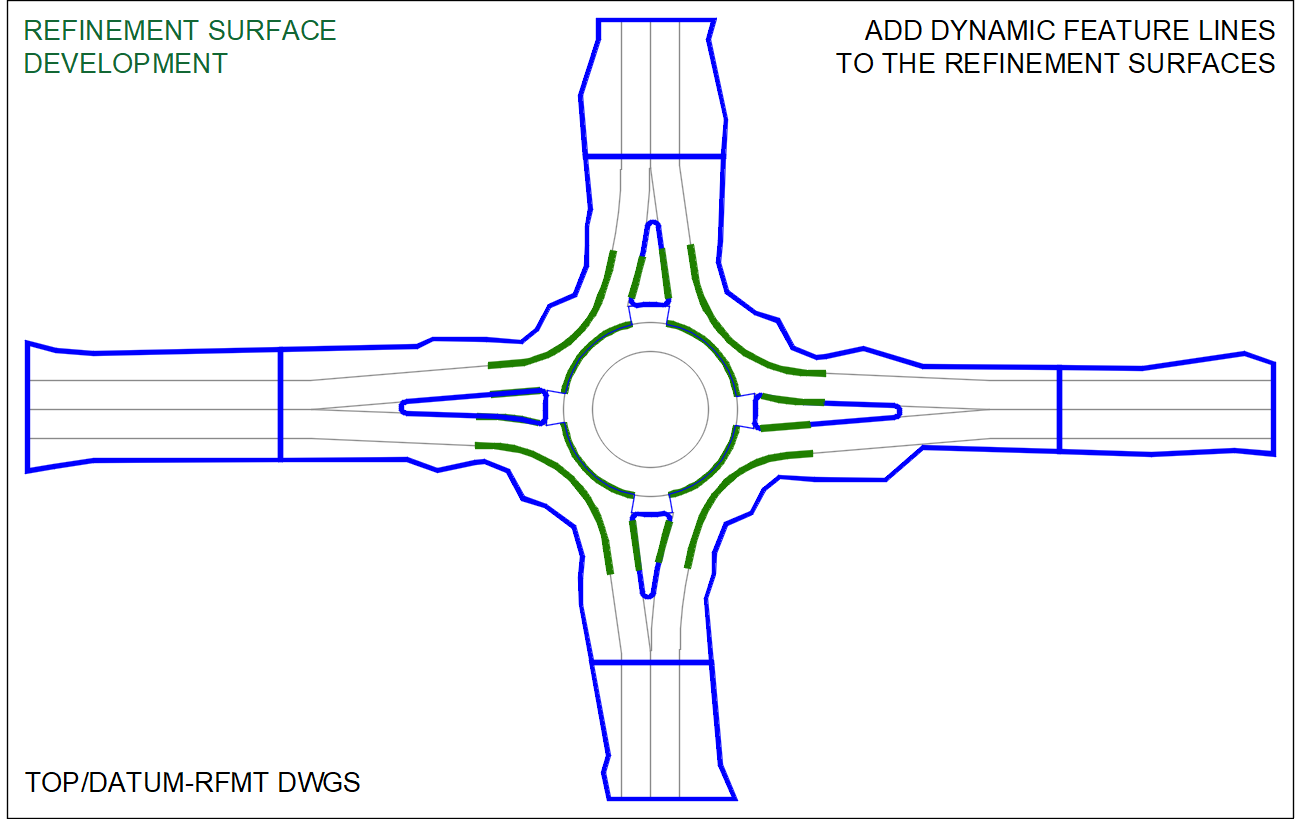Roundabout: vertical design - introduction
Last updated: 2025-06-02
Total video time: 22:58
 Overview
Overview
Video: rndbt-vrtcl-dsgn-intro-01.mp4 3:51
Roundabout projects require familiarization with the Roundabout sections in the FDM.
This training covers vertical design modeling workflows of profiles, corridors, and surfaces as it relates to the roundabout stages of development shown and described in FDM 11-26 Roundabouts 5.3, 5.3.2.
The emphasis of these workflows will be the vertical design elements covered as part of the DSR approval stage and final design for Pre-PSE submittal.
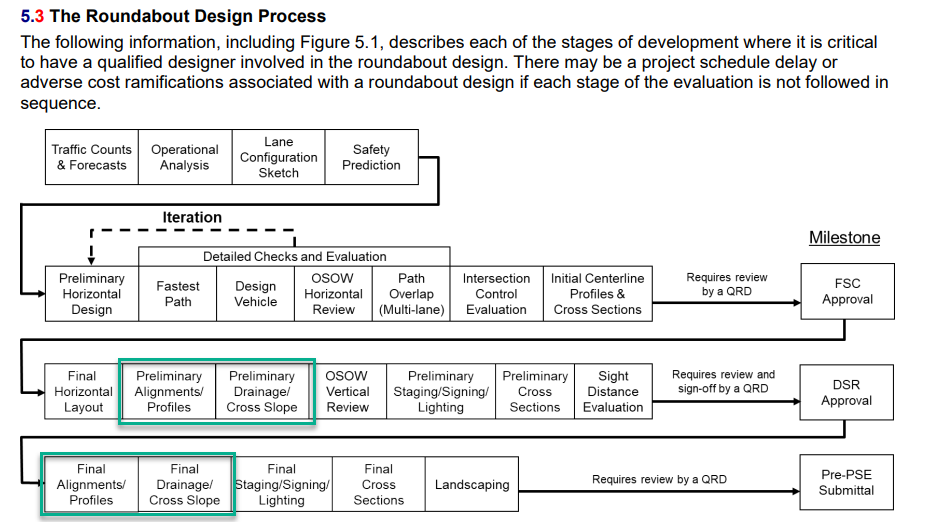
The roundabout workflow shown in this training are directly relate to what the FDM refers to as “one of the primary critical elements of design”. That critical element is the vertical control of the roundabout project.
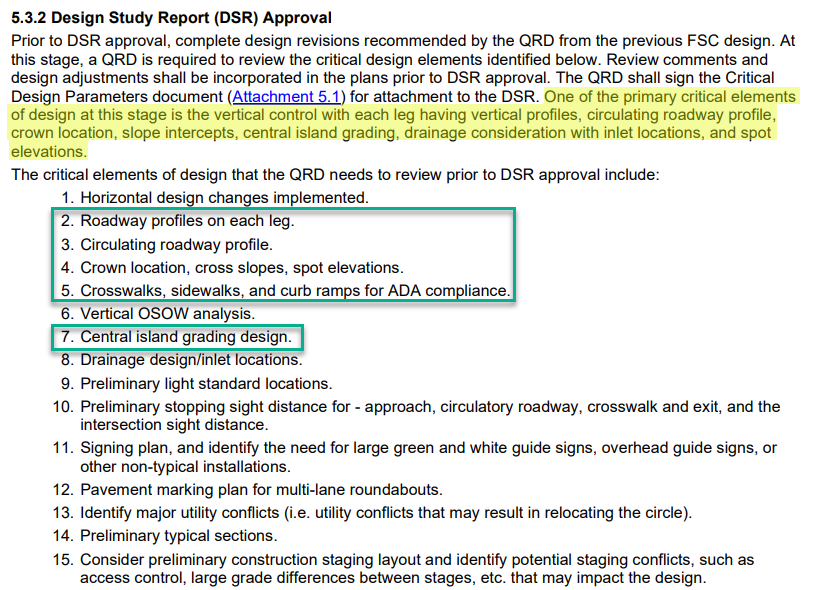
The workflows demonstrated in this roundabout training are examples of how to use Civil 3D tools to develop a vertical hierarchy model structure that will give design flexibility all the way through the design development process to final profiles, surfaces, and cross sections.
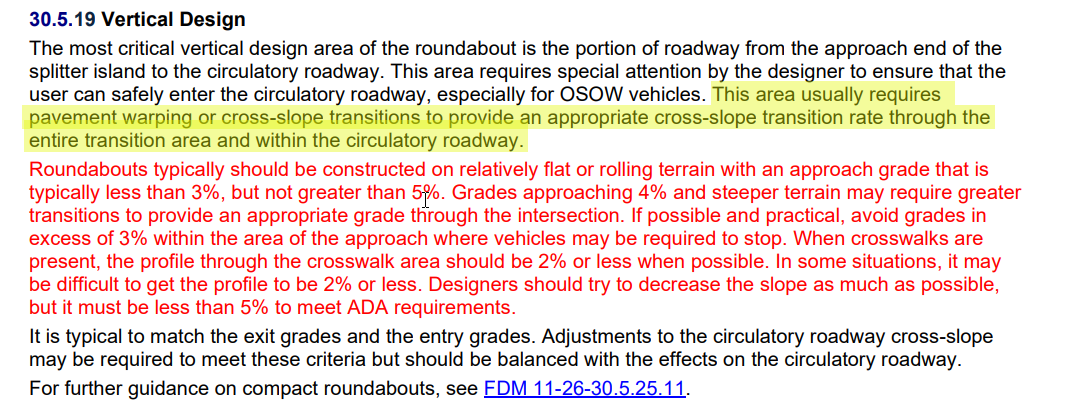
It is important with all design and modeling in Civil 3D to have a clear understanding of what objects and elements will be used during the design process. Creating a schematic or rough drawing of all the objects to be created with the relationships between each object and the naming scheme to use will not only assist in clarify the workflow but also help minimize errors and confusion.
The main civil objects that will be used to develop the vertical hierarchy system (or vertical backbone) are alignments, design profiles, surface profiles, corridors, surfaces, intersection objects, control profiles and superelevations.
Develop storyboard of vertical model development
The following diagrams are created in a storyboard format to illustrate the concept of planning this vertical control process. Creating this linear reference progression in a storyboard format may help develop a clear understanding of the elements required, the timeline in which the elements need to be developed, and the relationship between the elements of the design.
Roundabout Alignment Diagrams
This diagram is to give some context to the roundabout alignments that will be needed to create the vertical control structure as it follows the alignment and profile criteria described in FDM 11-26 Roundabouts 30.6.2.
- An alignment along the curb gutter flange line located between the truck apron and the circulatory roadway.
- An alignment at the roundabout ends of the splitter island flange lines will define the outer circulatory roadway.
- The baseline alignments that run along each side of the splitter island will be referred to as primary and secondary alignments. The primary alignments will run in the east and north travel direction and the secondary alignments will run in the west and south travel directions.
- Other alignments needed will be the outer edge of pavement alignments. These will run along each quadrant and will not run across the roundabout like with a typical intersection.
- Curb return alignments will be needed and the workflow for these will be very similar to the typical rural intersection workflow.
- Splitter island alignments will be used to define the vertical geometry.
-
In this diagram you can see that we are basically creating eight (8) T intersections.
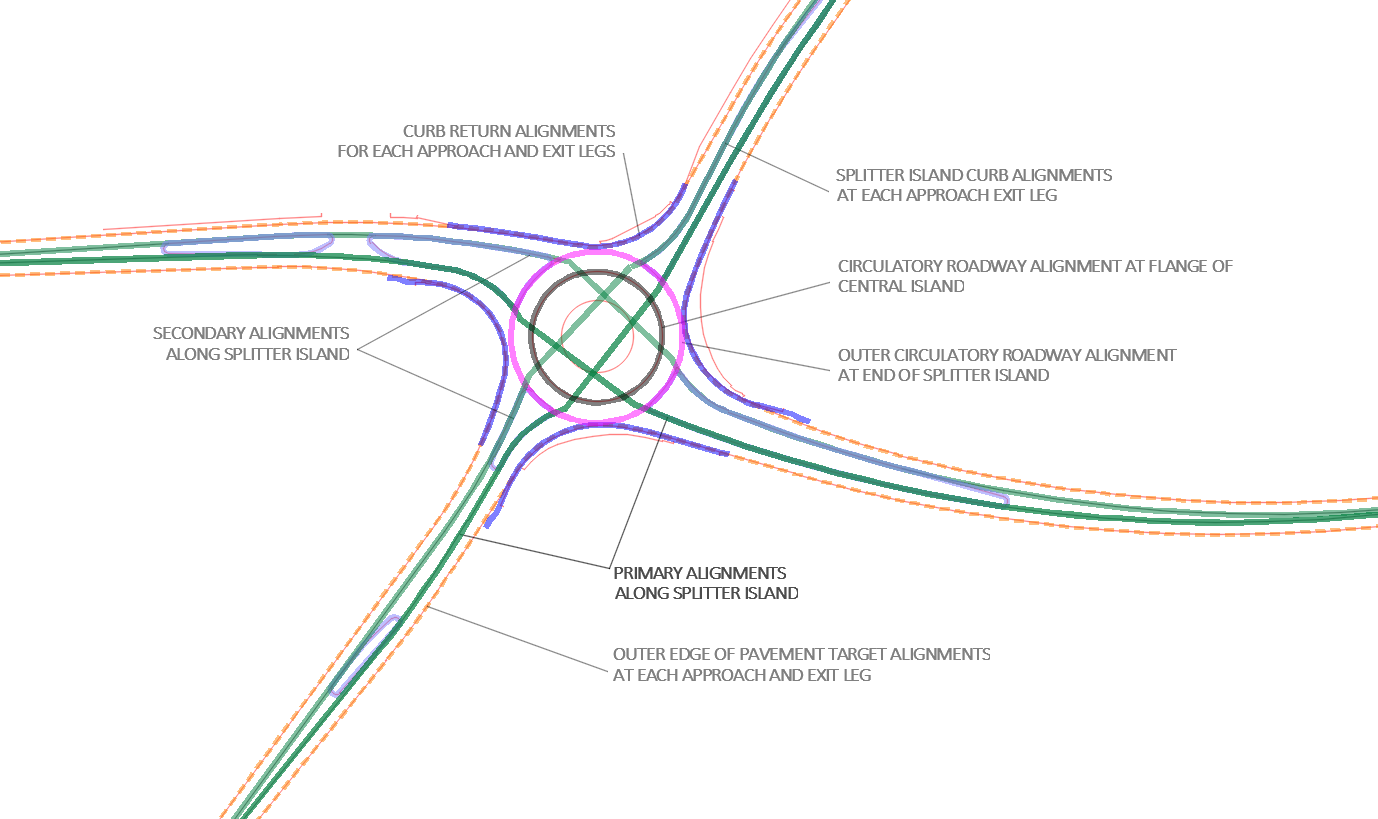
 Horizontal geometry development
Horizontal geometry development
Video: rndbt-vrtcl-dsgn-intro-02.mp4 3:13
- Extract Linework from roundabout edge line drawing
In this roundabout example we are assuming that a 2D edge line drawing is provided by the Roundabout engineer and the design engineer is tasked with developing the baseline alignments. The designer working closely with the Roundabout engineer may already have developed baseline alignments using different methods. The workflow we will be showing here is to extract edge line objects from an edge line dwg that is x-referenced into the aliprof dwg.
- FDM 11-26 Roundabouts 30.6.2
Info: Info: The edge line drawing will be Xref’d into the rdbt-ali-prof.dwg.

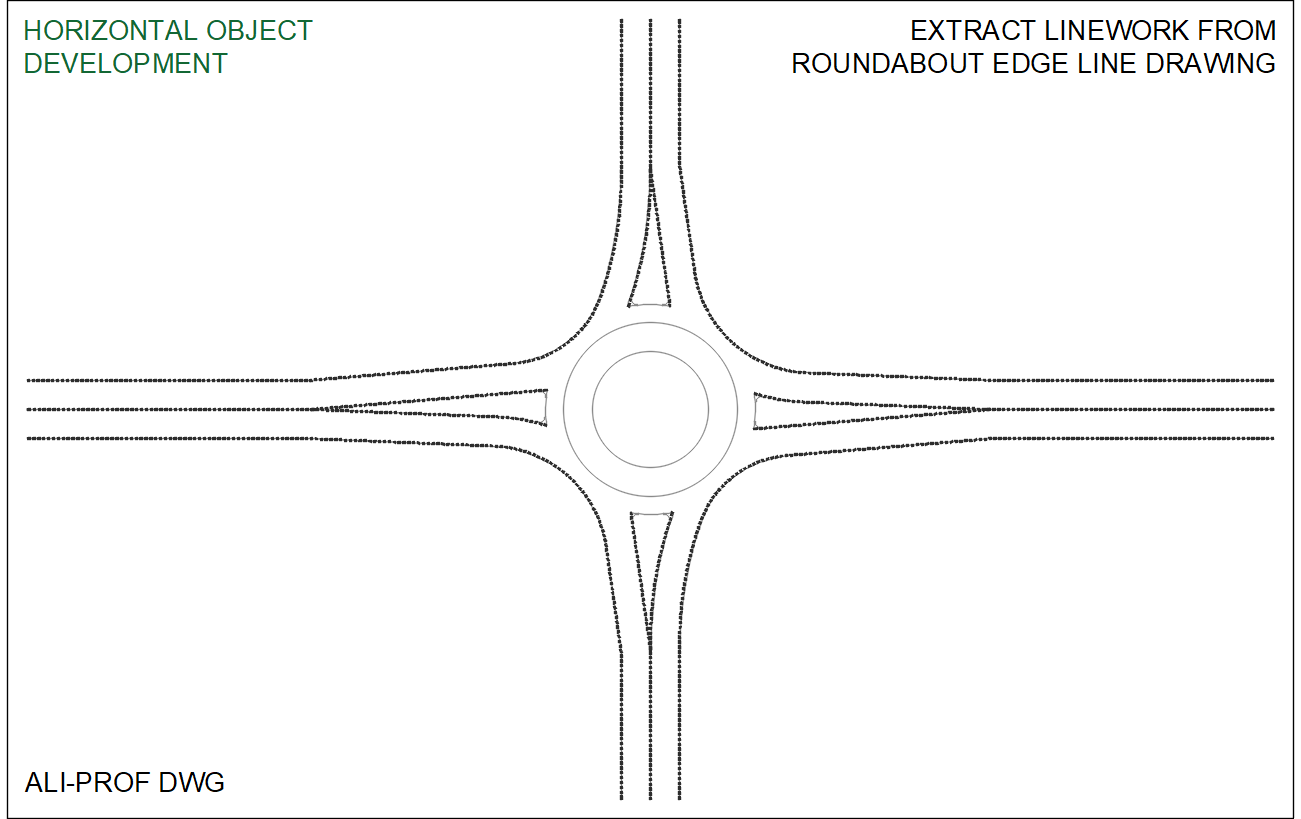
- FDM 11-26 Roundabouts 30.6.2
- Develop a top surface Titled Plane
If we look at the Profile Information section of the Roundabout chapter in the FDM the base hierarchy element of our vertical design is described. FDM 11-26 Roundabouts 30.6.3.
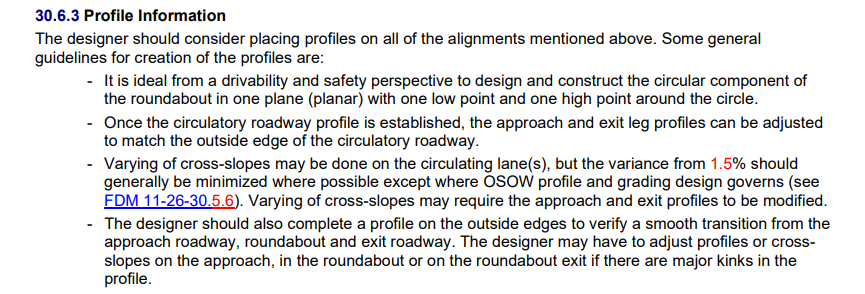
Comment: “It is ideal from a drivability and safety perspective to design and construct the circular component of the roundabout in one plane (planar) with one low point and one high point around the circle.”
To create and maintain the circle as a singular planar surface the concept of a tilted plane has been introduced.
The titled plane surface will act as the base vertical design element and will control the elevation of the central island and the singular slope across it.
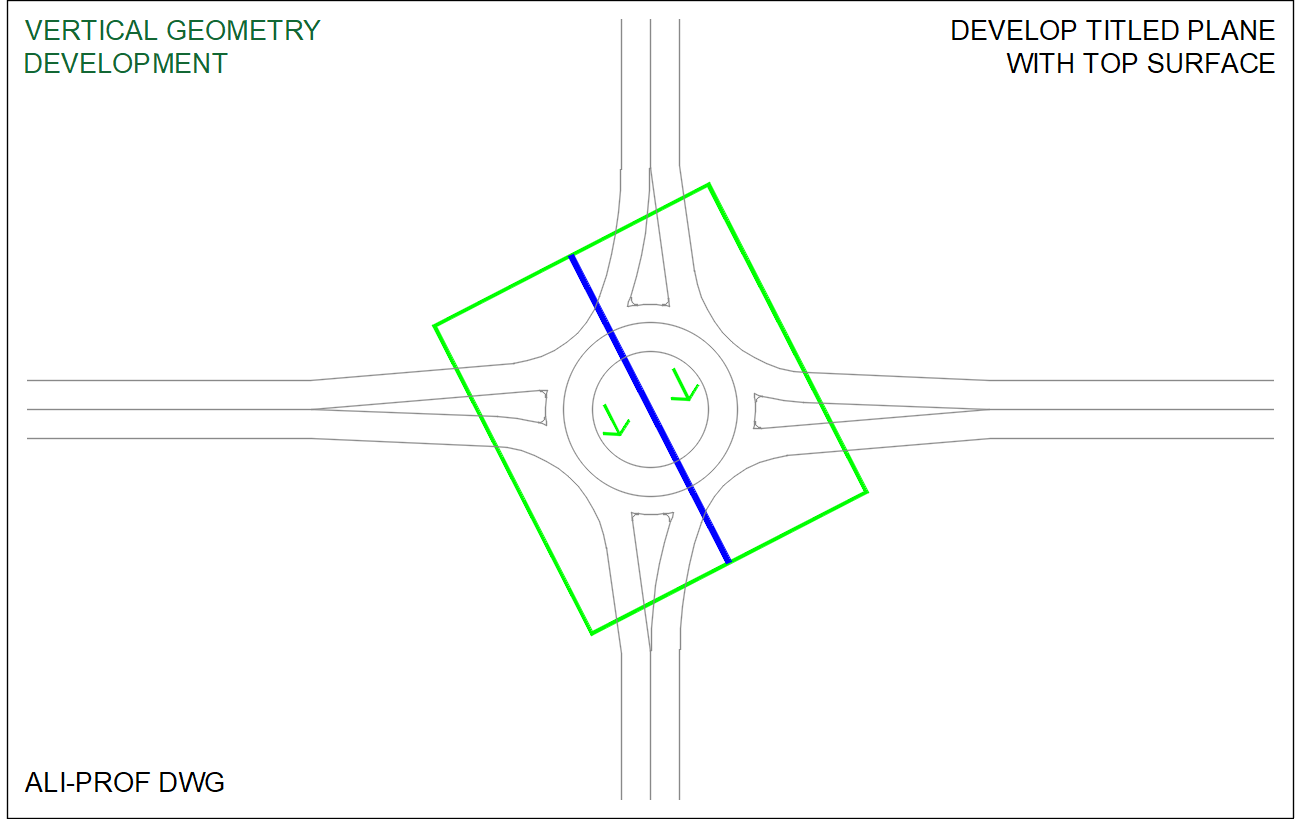
- Create circulatory roadway alignment (inner)
The FDM established that we should have a circulatory roadway alignment at the curb flange edge of the central island.
The working design profile for this alignment will be a surface profile sampled from the tilted plane surface.
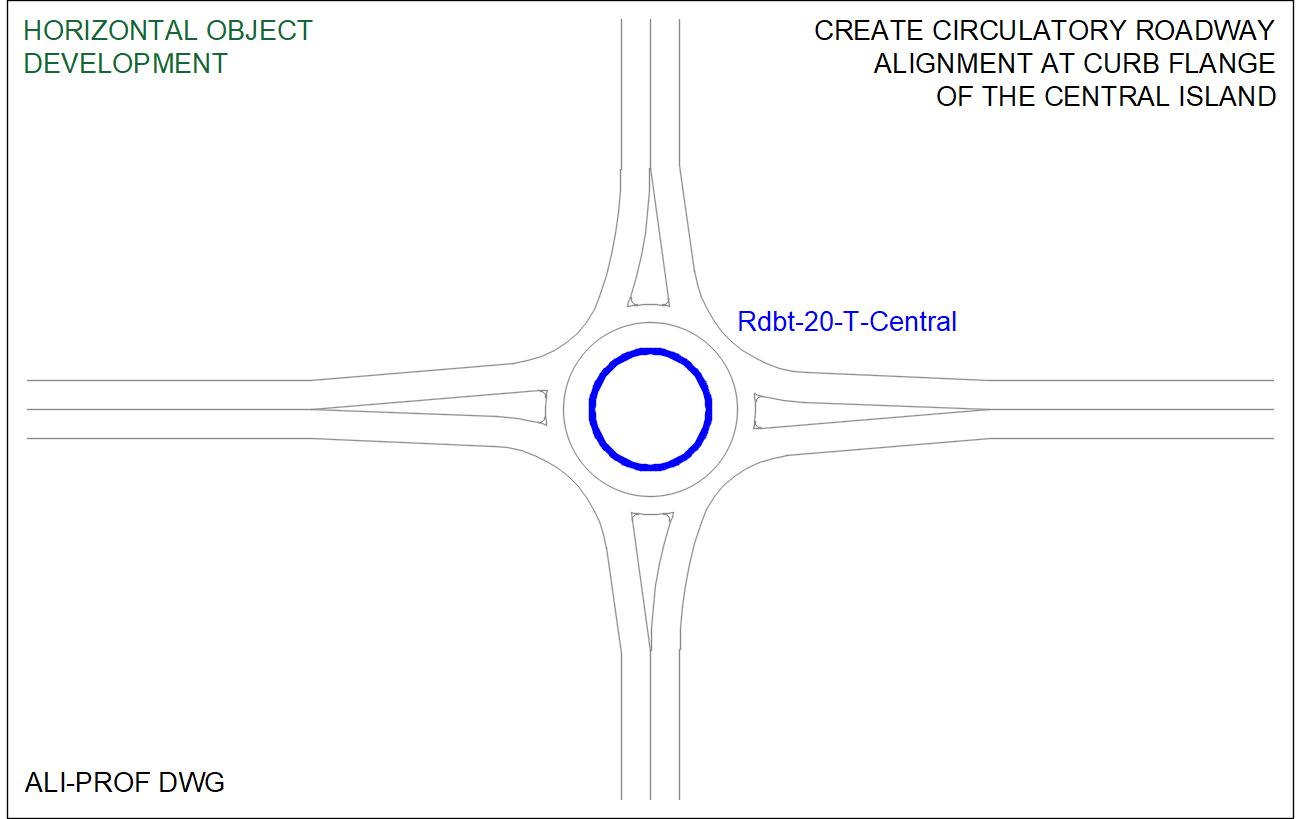
- Create the outer circulatory roadway construction alignment
The circulatory roadway will be crowned 12 ft from the central island curb flange and the splitter islands will be 8ft outward from the crown. (recommended circulatory roadway crown installed, at 2/3 inward and 1/3 outward).
We will create an outer circulatory roadway construction alignment that runs along the ends of the splitter islands.
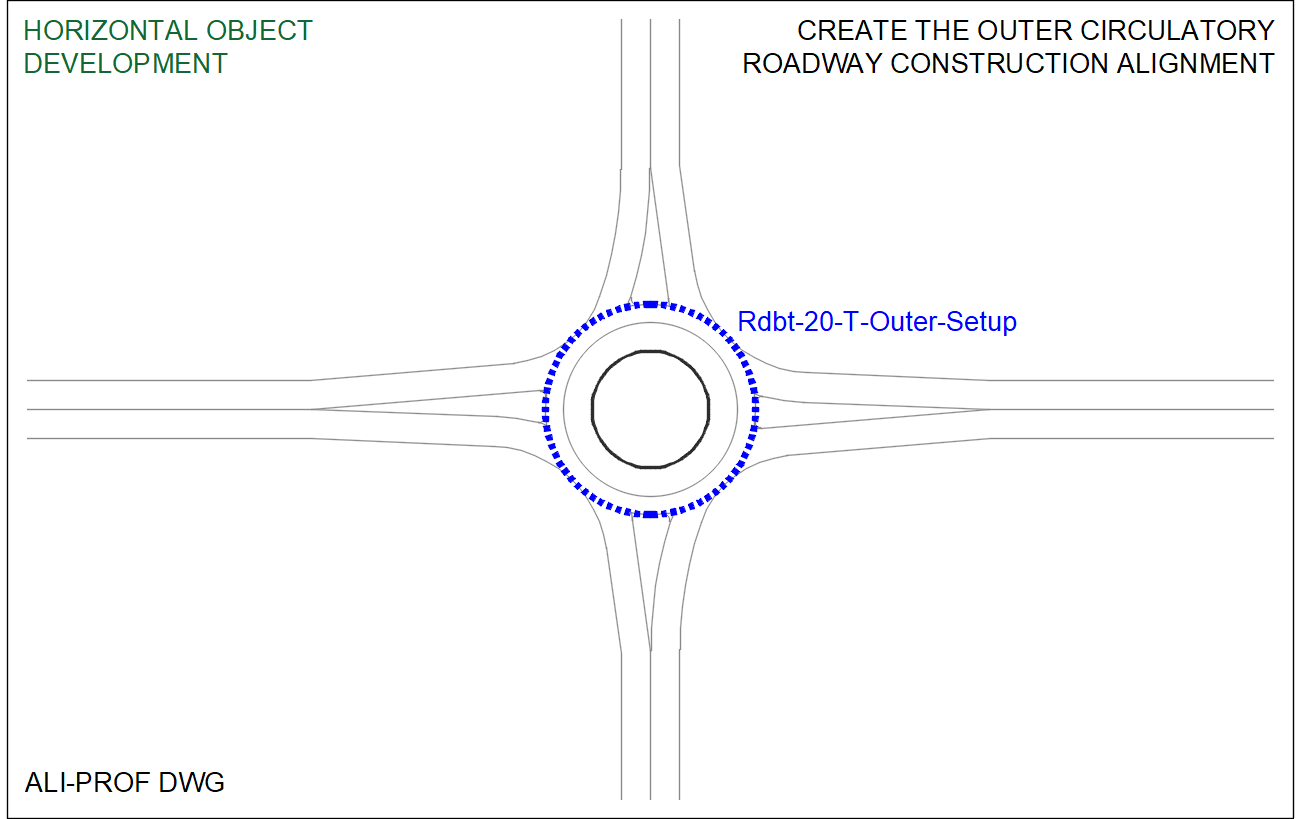
- Create primary baseline alignments
Using the extracted objects from the edgeline drawing, create primary baseline alignments from the extracted edge line objects. These alignments run along the curb flange edge of the splitter island.
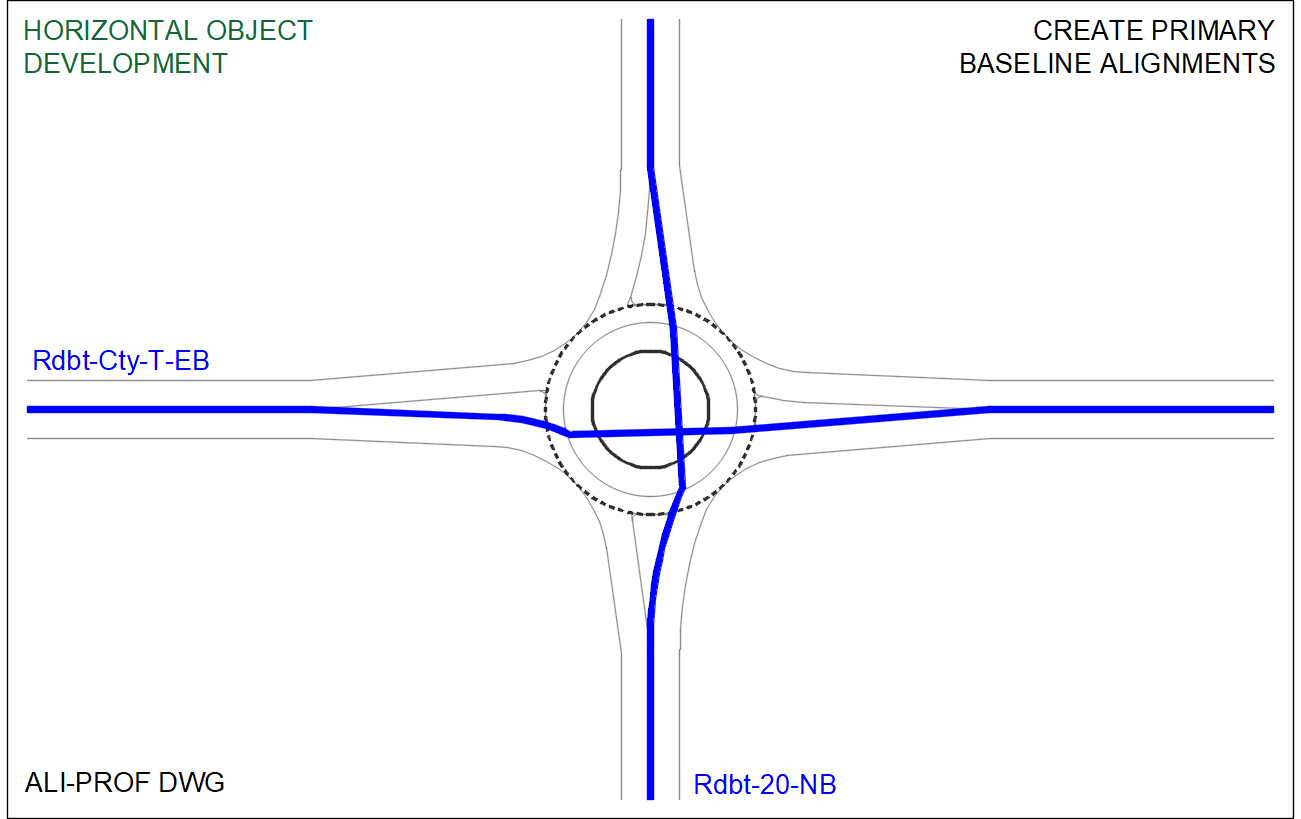
- Create secondary baseline alignments
Using the extracted objects from the edgeline drawing, create secondary baseline alignments from the extracted edge line objects. These alignments run along the curb flange edge of the splitter island.
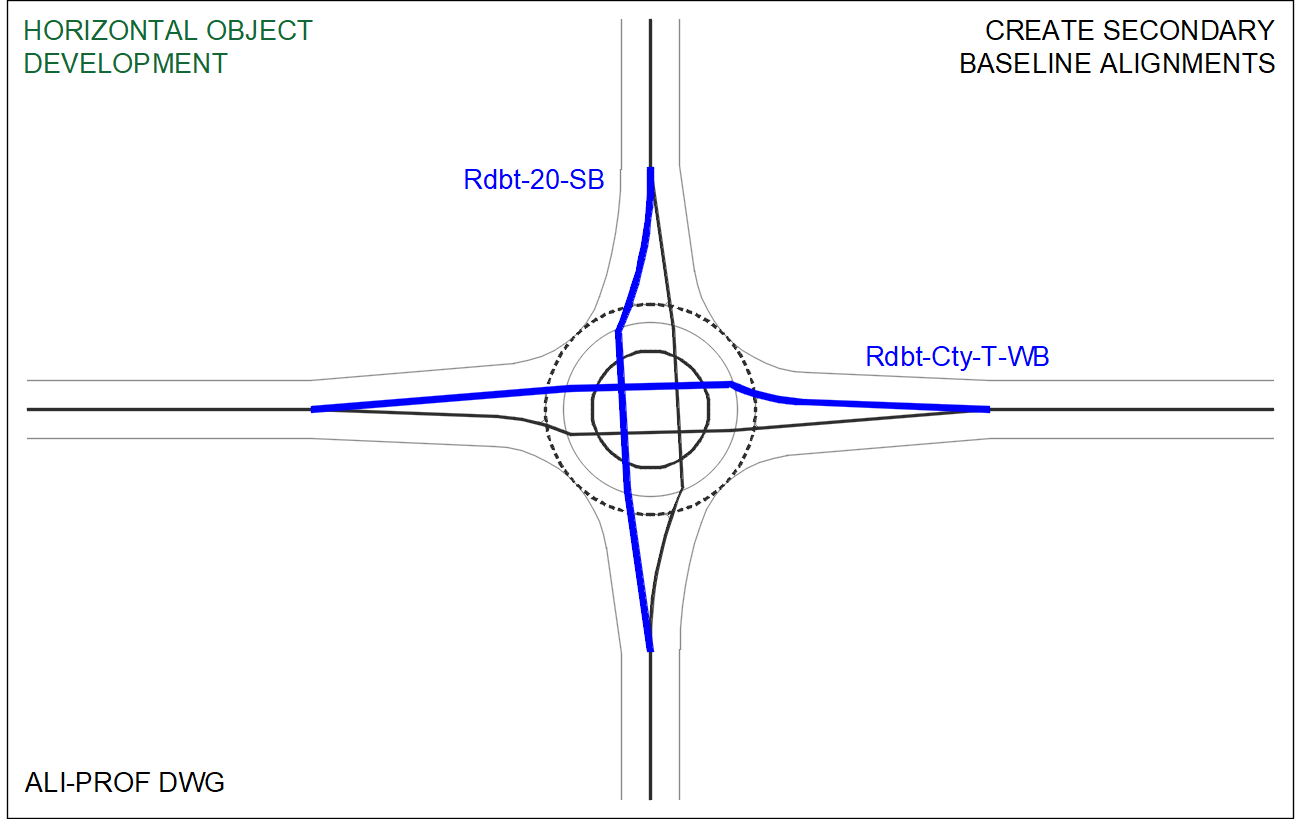
- Create outer edge of pavement alignments
Using the extracted objects from the edgeline drawing, create the outer edge of pavement alignments by. These alignments do not cross over the circulatory roadway but are create in each quadrant and extend along the pavement edge of each entry and exit lane.
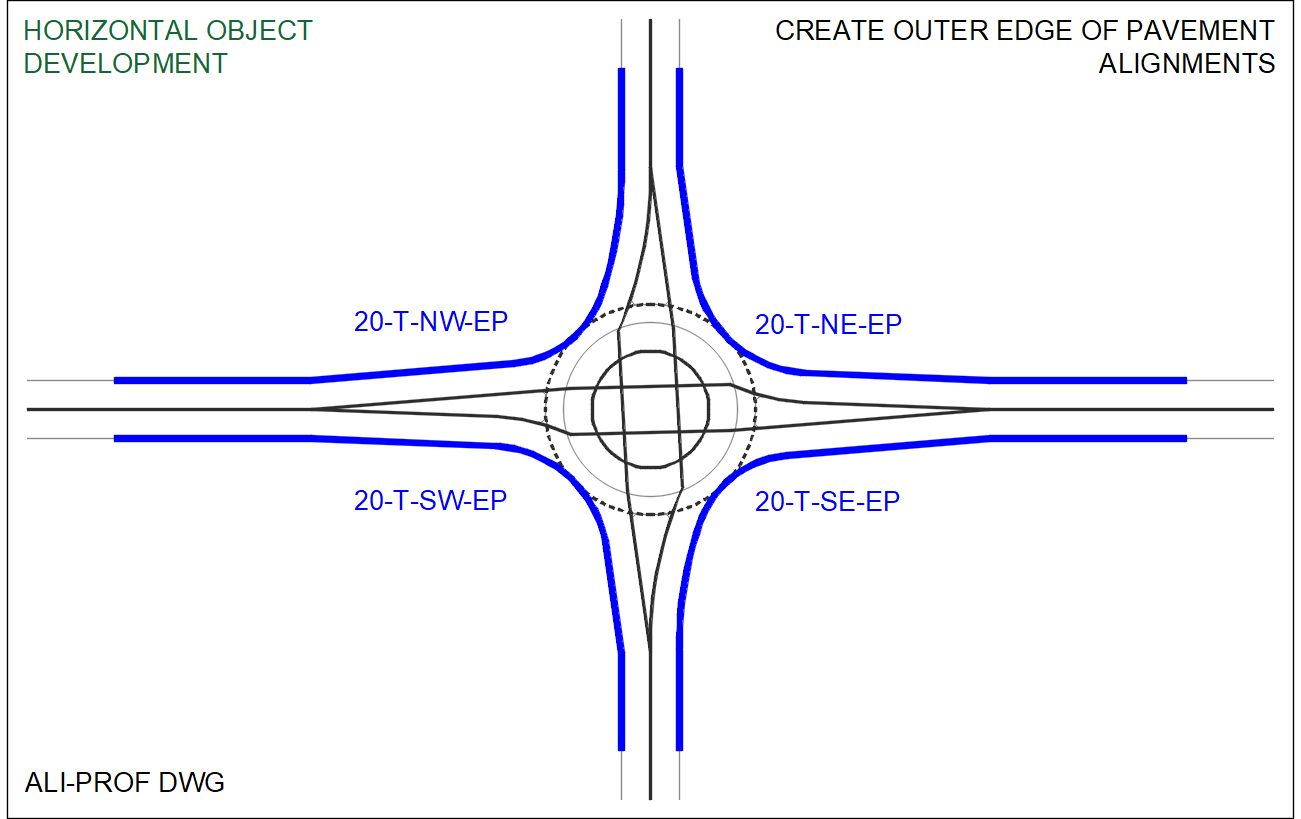
- Develop the curb return alignments
Use the copy alignment tool to help develop the curb return alignments from the outer edge of pavement alignments. Additional development to design the curb end conditions is required.
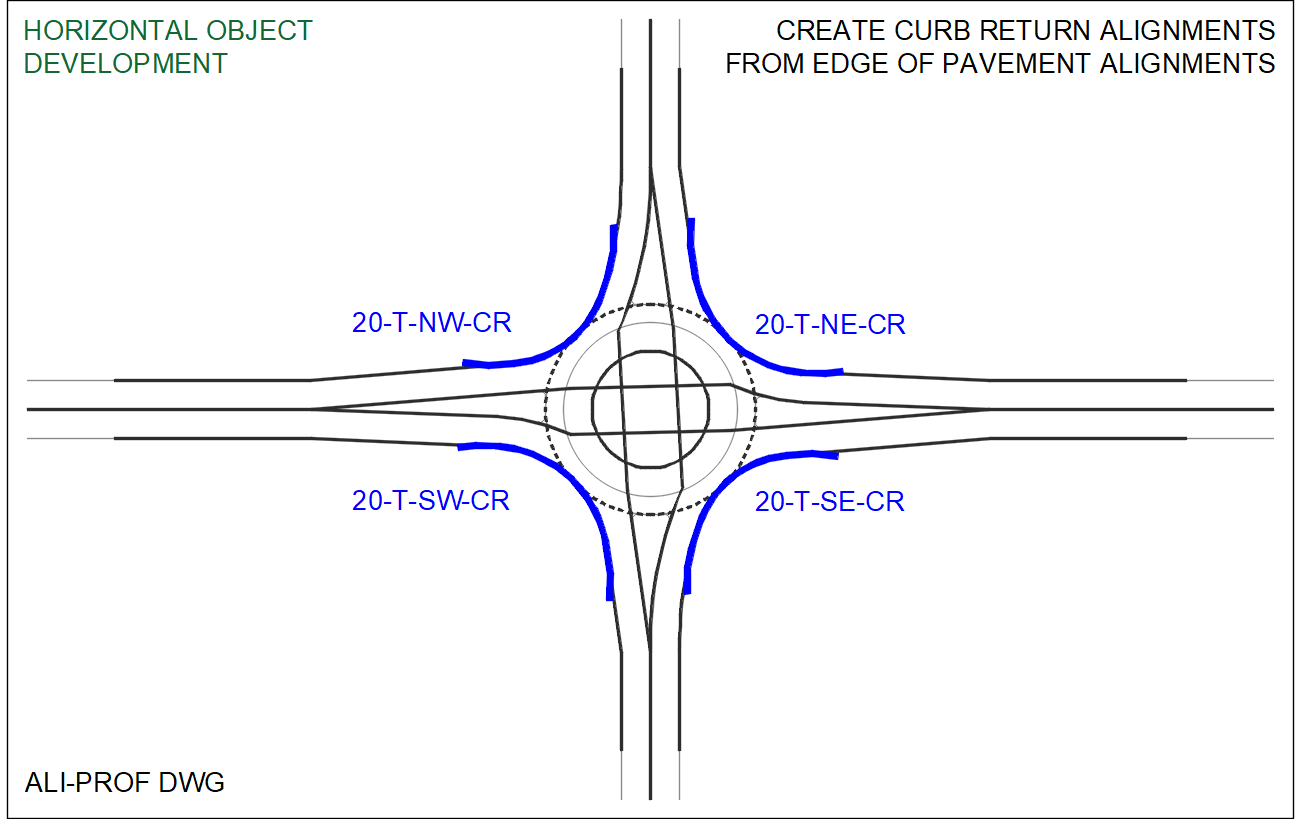
- Develop match-line alignments
Match line alignments will be created along each leg where existing conditions or design corridors of the roadway legs end. One way to think of it is that the match line defines where the typical roadway corridors end, and the roundabout workflow begins. The match line profile will serve to match the roundabout profiles to these separate leg surface elevations.
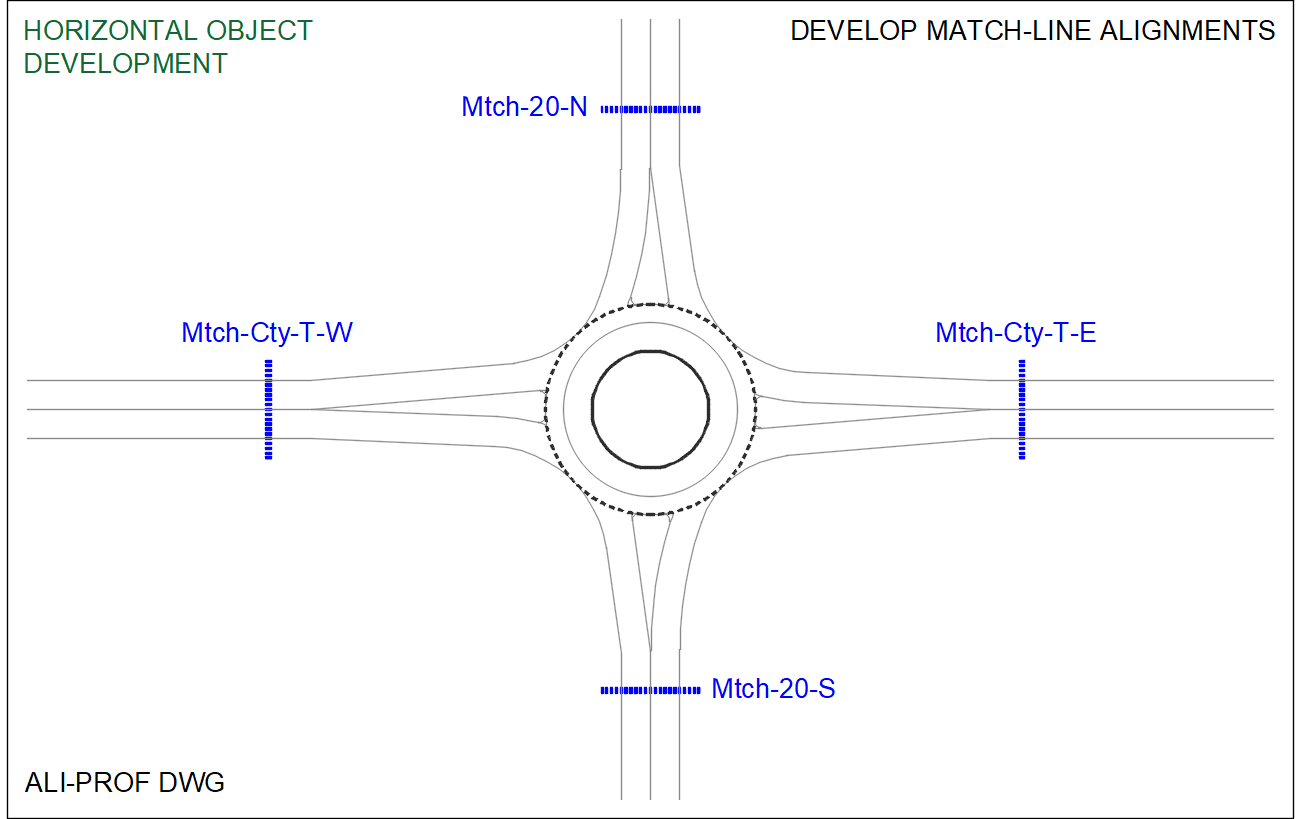
 Vertical geometry development
Vertical geometry development
Videos: rndbt-vrtcl-dsgn-intro-03.mp4 3:32, rndbt-vrtcl-dsgn-intro-04.mp4 4:43
- Create circulatory roadway alignment profile
Once all the alignments are created from the edgeline geometry, it is time to create the central island profile as a sampled surface profile of the tilted plane surface.
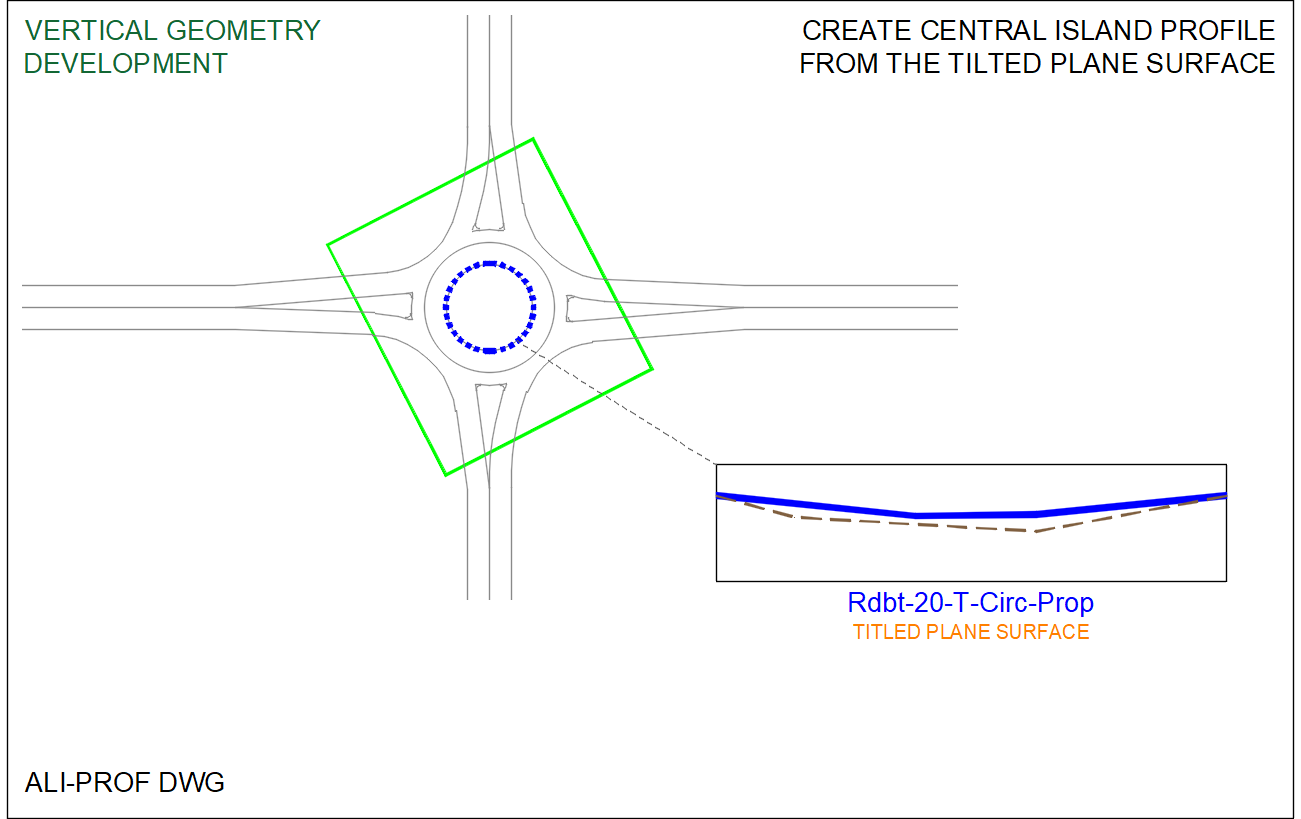
- Develop circulatory roadway crowned setup surface
Here is where we will create the circulatory roadway crowned setup surface so we can establish the crown and the elevations at the ends of each splitter island. This corridor uses the central island profile to establish the inside elevations. Where does the central island sample it’s profile from? Right, the tilted plane surface. If fine tuning cross slope transitions is necessary, they may be defined through targeting control profiles or using other corridor transition methods.
The assembly we use to create the top setup surface, will also include the min and max cross slopes. A Min, Max and Norm surface will be created to use with the curb return profile creation workflow.
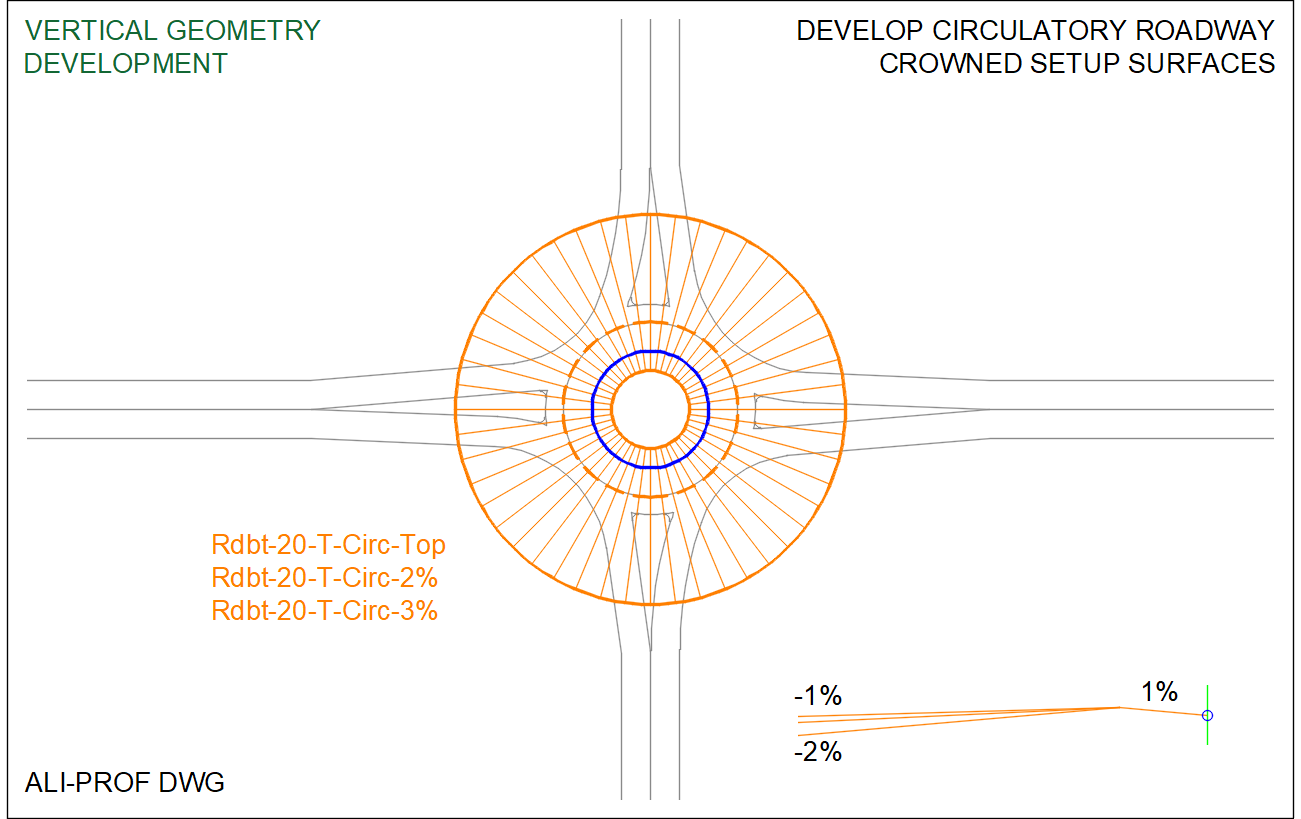
- Create the outer circulatory roadway profile
This step will extend the vertical control hierarchy out from the tilted plane to the central island profile, to the crowned setup surface to the outer circulatory roadway construction profile. The profile will be a surface profile that samples the crowned setup surface. Now we have a profile at the end of the splitter islands that we can use to tie those elevations to the primary profiles of each leg.
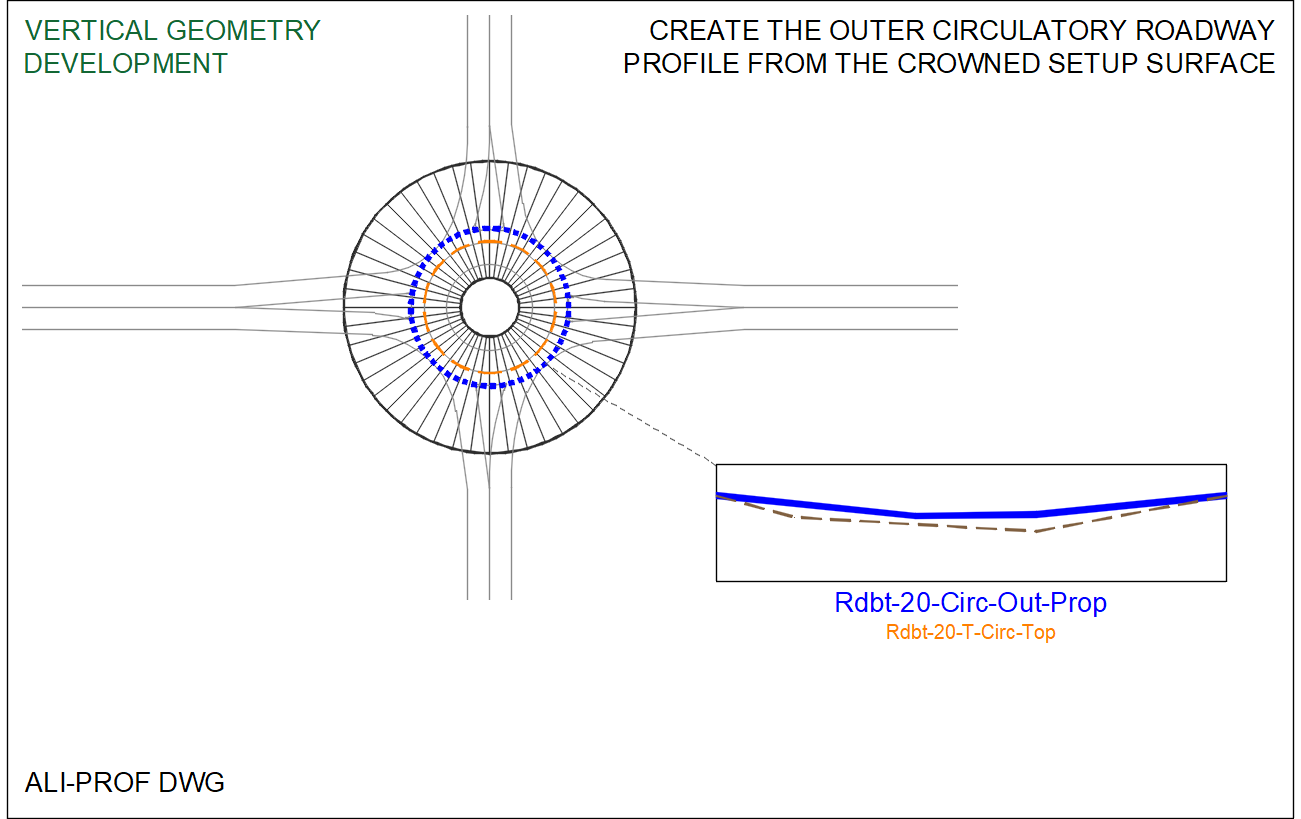
- Develop primary alignment profiles
The next part of the vertical design is to create the primary profiles. At this point these profiles can be a simple tangent between the match lines so critical elevations may be added along the profiles.
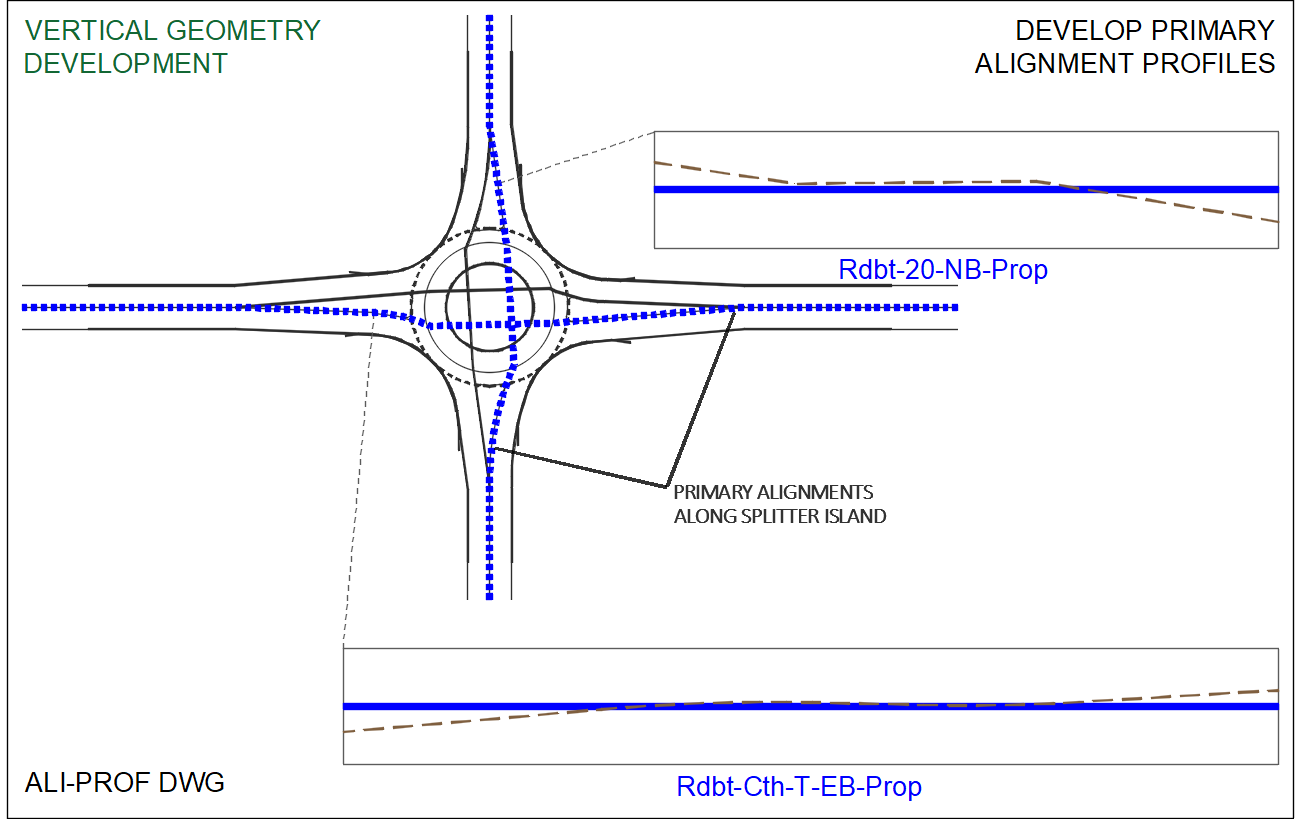
- Create primary profile intersection objects
So, if you caught the foreshadowing, the next thing we will create is the primary profile intersection objects and assign the priority elevation to the outer circulatory roadway profile. Here is where we are establishing the vertical control of the circulatory roadway to each leg profile.
After the intersections are added to the primary profiles, further design development will need to be added to the profiles along each leg extending past the matchline alignments. These profiles should extend past the matchline alignments but where possible be coincidental to the profiles being used for the roadways beyond the matchline.
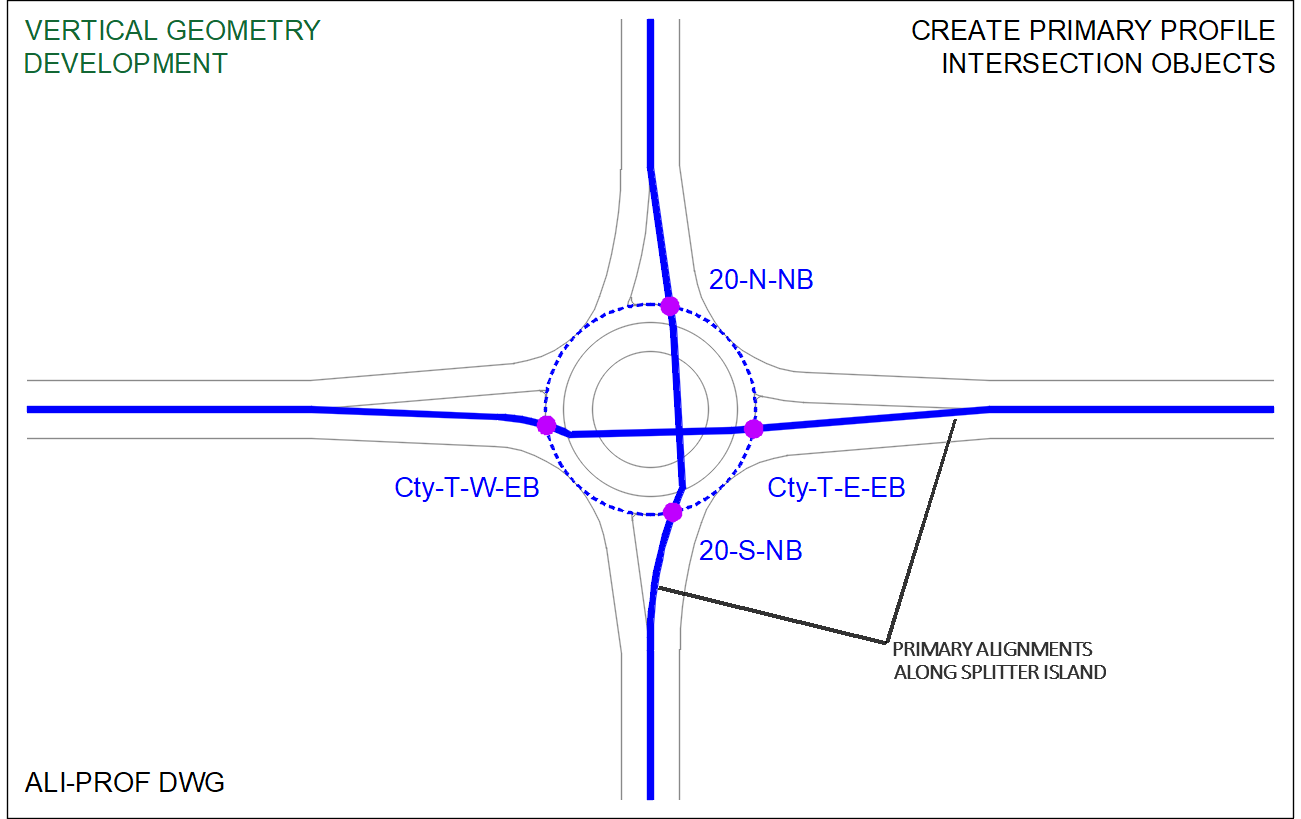
- Develop roadways corridors for each leg
Develop full roadway alignments, profiles, and corridors for each leg to stop at the match line alignment. Each leg should be a separate corridor with a top and datum surface created. These corridors could be part of a larger project than just the roundabout, but should stop at the matchlines and could be develop independently of this roundabout workflow.
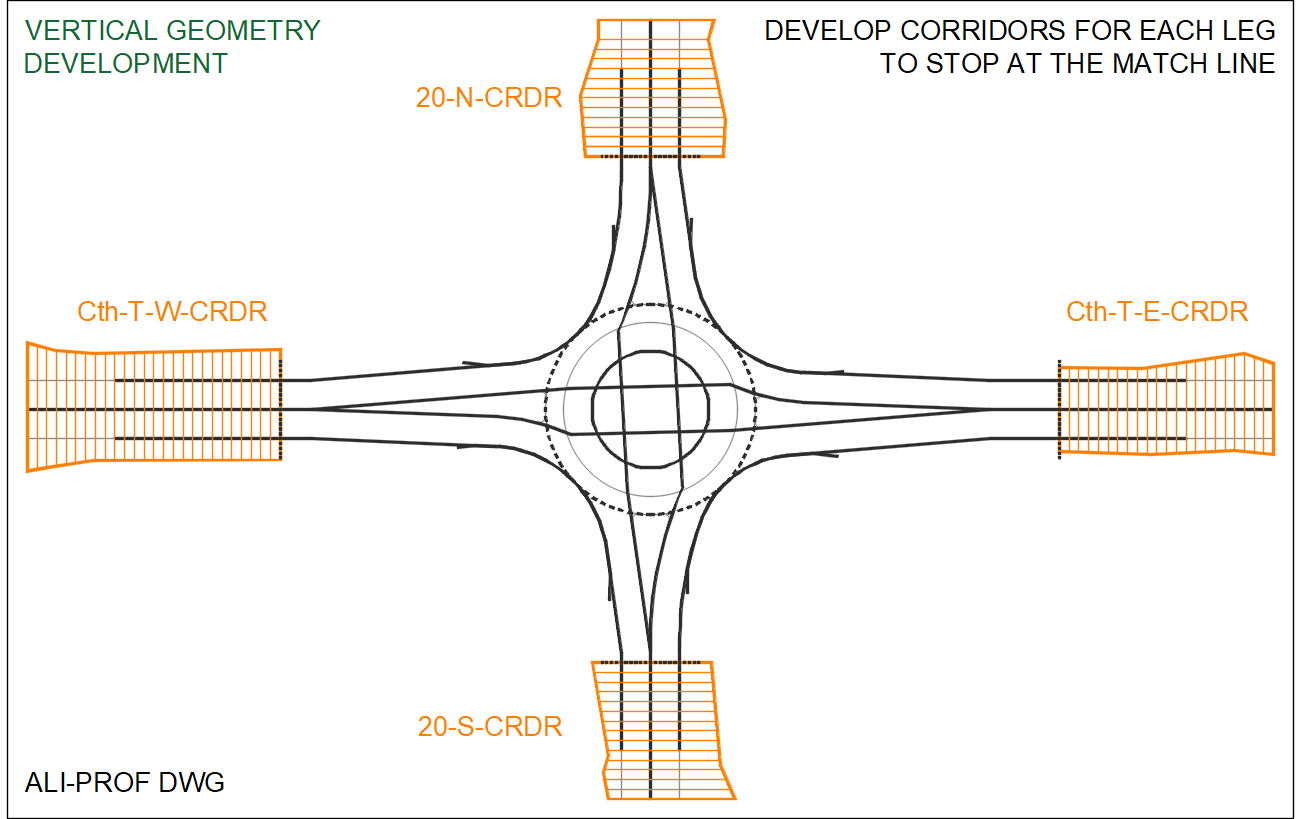
- Create matchline profiles and intersection objects
With each corridor leg completed, a matchline profile can be create that samples the top surface for that leg. At this point we can create an intersection object to tie each primary design profile to the elevations of the matchline profile.
This completes the vertical control of the primary profiles. Now the primary profile elevation is controlled at the match line by the outer corridors of each leg and controlled at the circulatory roadway by the crowned setup corridor.
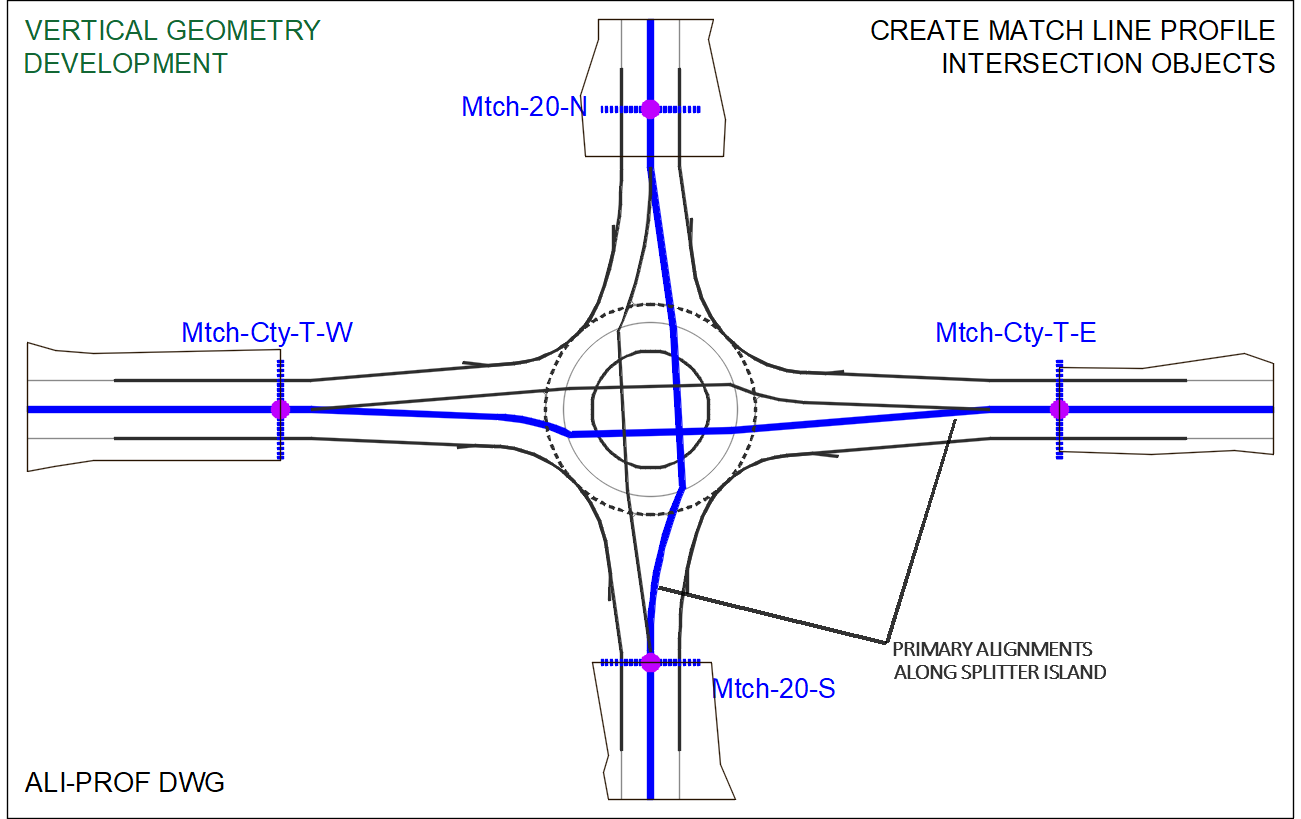
- Create secondary alignment profiles
Create the secondary profiles. At this point the profiles should just be a single tangent from start to end. Further elevations and vertical geometry will be added.
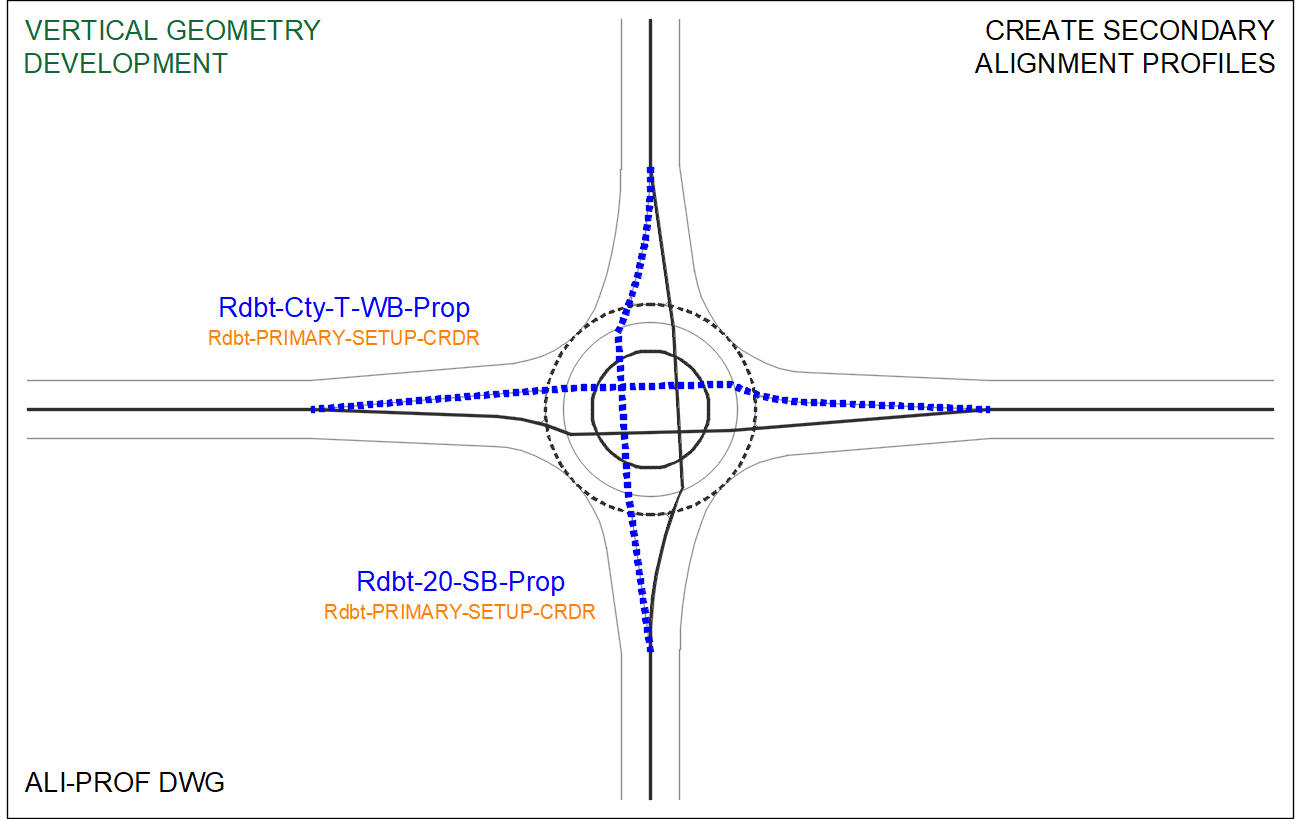
- Create secondary profiles intersection objects
Create the secondary profile intersection objects. Both profiles will be tied to the outer circulatory roadway profile with an intersection object and tied on the other end of the profile to the primary profile with an intersection object.
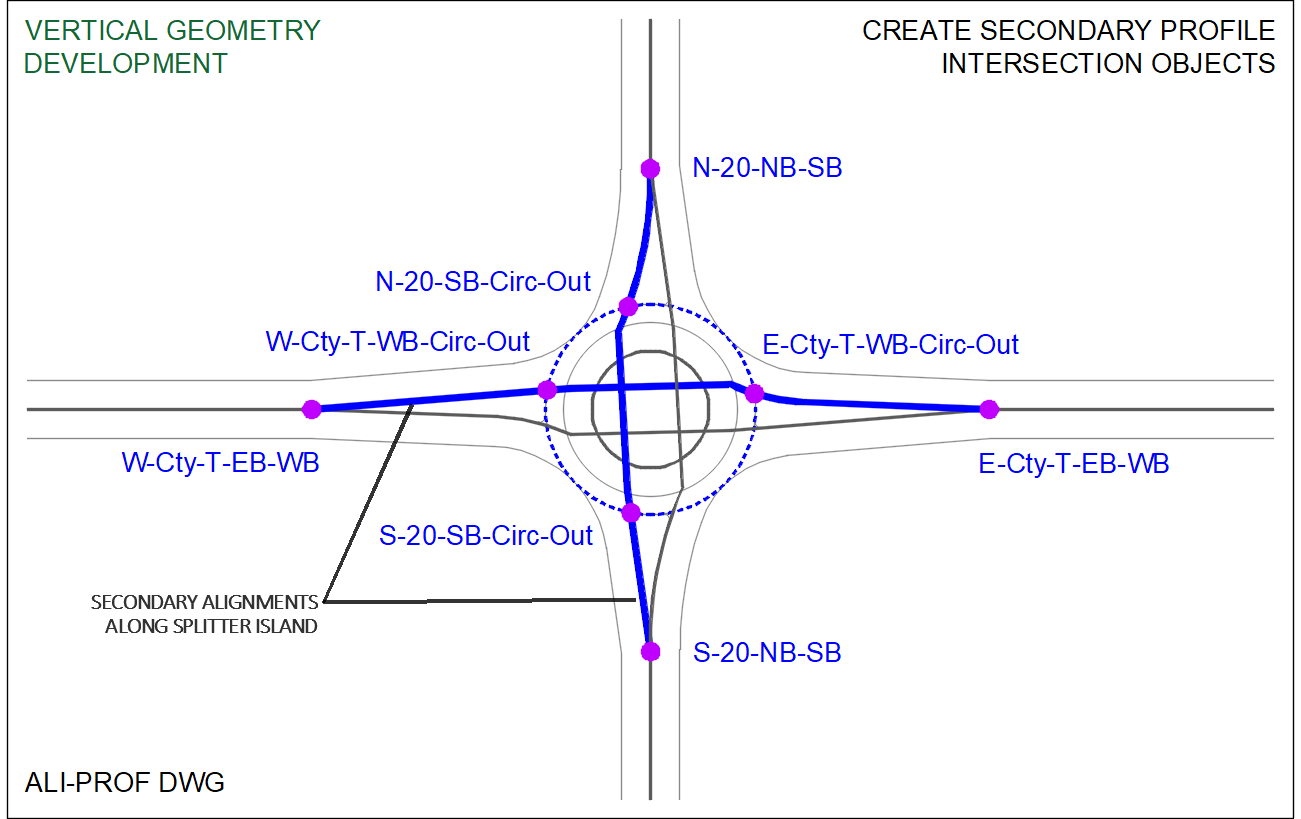
- Develop primary setup corridor top surfaces
At this stage we will create a setup corridor top surface along each leg of the primary alignments. The corridors will use control profiles to define the cross slopes. These surfaces will assist in developing the grading across the splitter islands and the outer edge of pavement profiles. This where we can set the cross slopes and test the transitions of some of the incoming and outgoing lanes by using simple link assemblies.
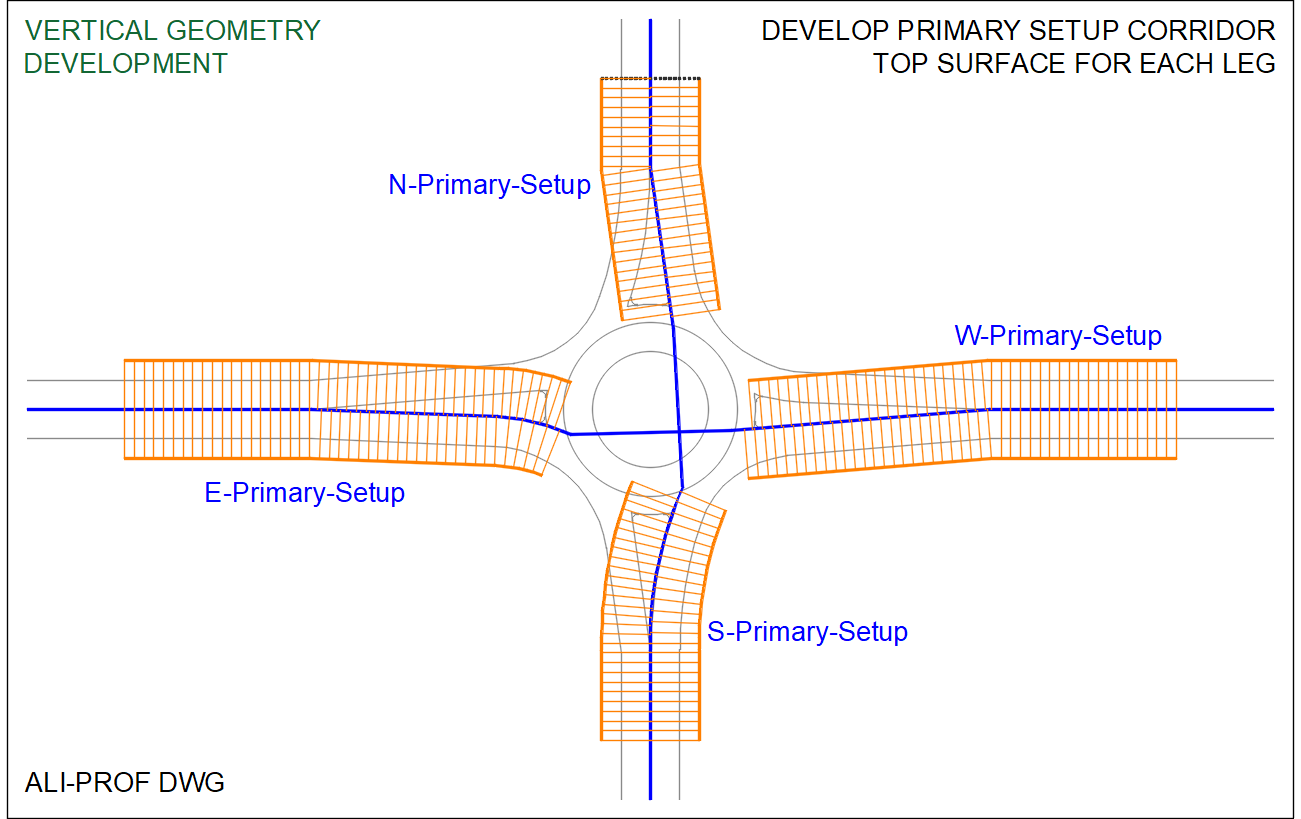
- Develop Secondary profiles
From the setup surface we create surface profiles along the secondary alignments. We can use these surface profiles as a guide to create the secondary alignment design profile. Remember each secondary profile already has locked elevations defined where they intersect the primary alignments and where it meets the circulatory roadway.
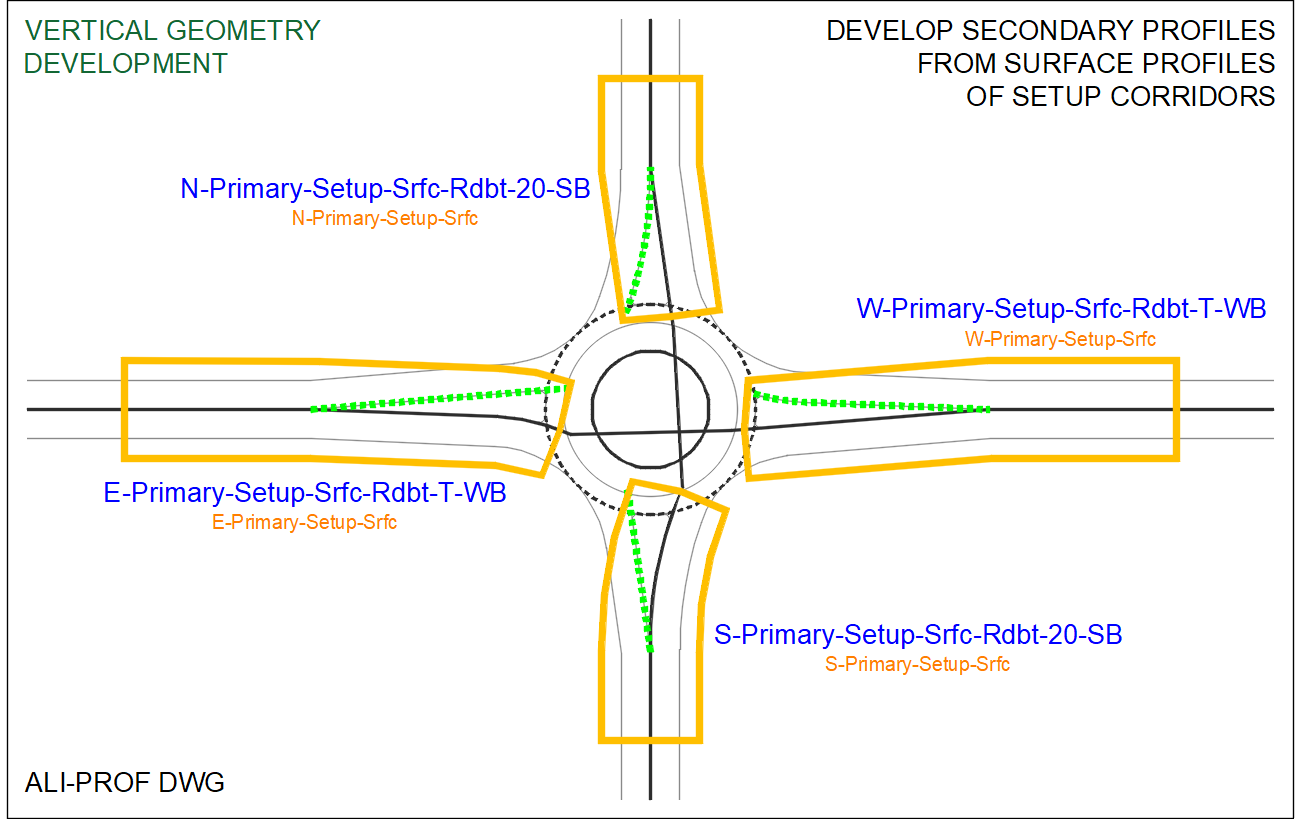
- Develop secondary setup corridor top surface
A setup corridor top surface will be created along each leg of the secondary alignments. The corridors use control profiles to define the cross slopes. These surfaces will also assist in developing the outer edge of pavement profiles.
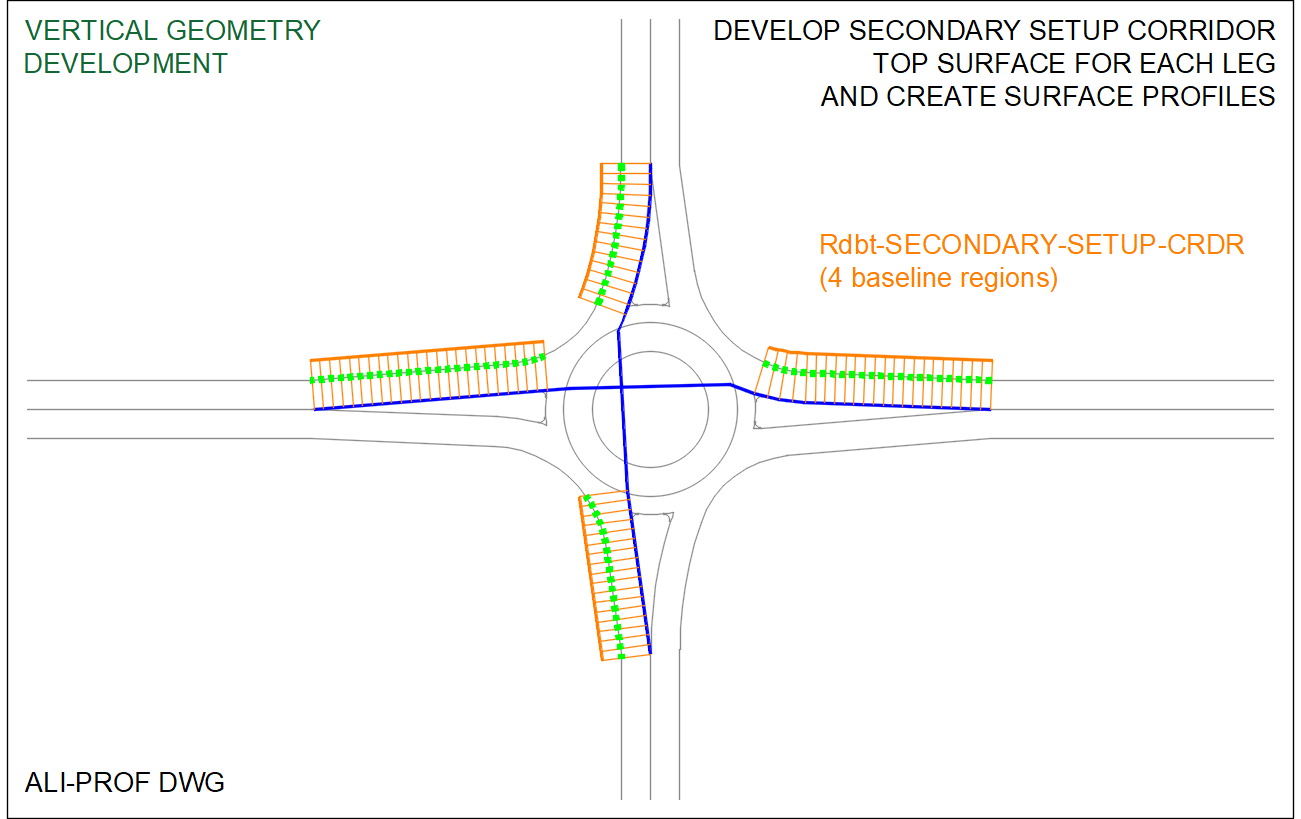
- Develop outer edge of pavement profiles
Using the surface profiles created from the primary and secondary setup corridors, the outer edge of pavement profiles may be created. It may be advantageous to maintain these profiles as surface profiles until the vertical geometry is well defined.
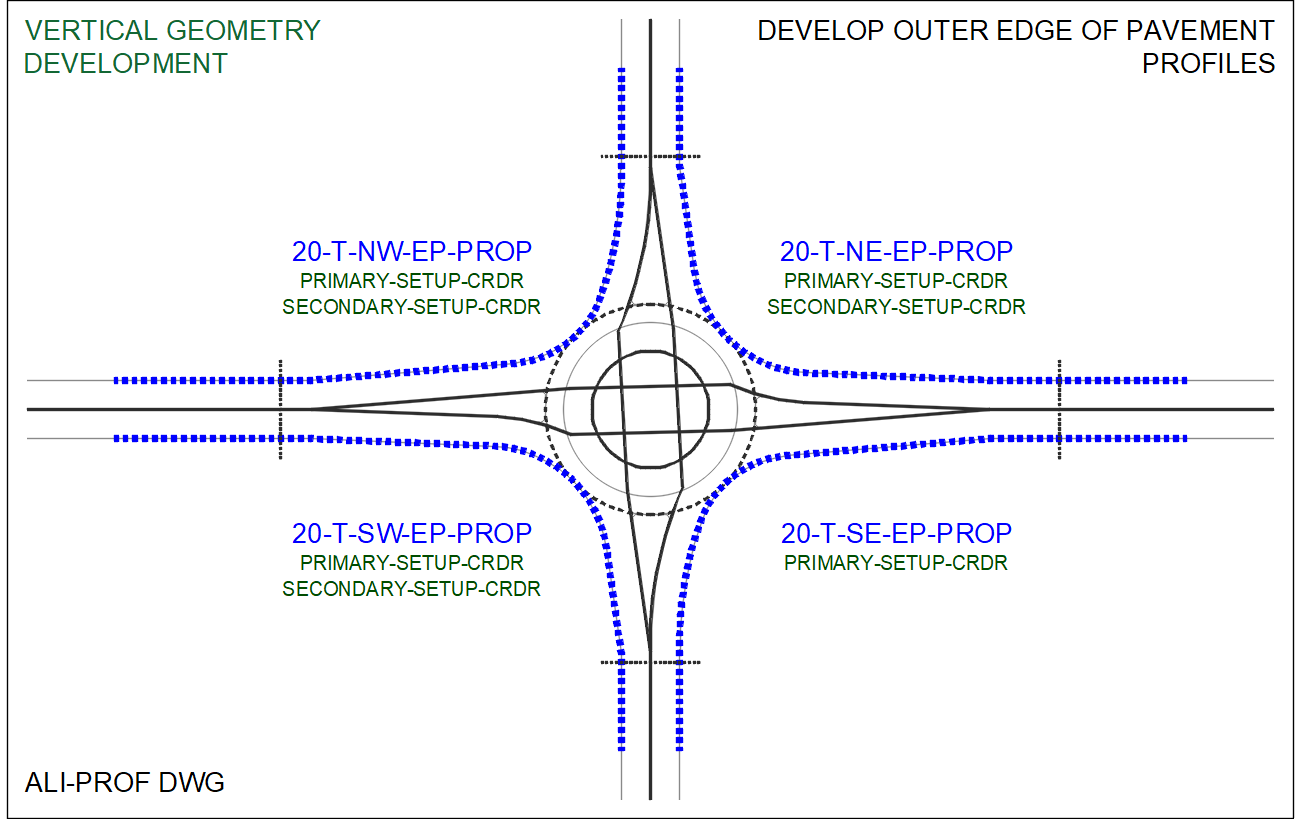
- Create curb return profile intersection objects
If you haven’t guessed, it is intersection object time again. Here the intersection objects will be used to tie the coincidental ends of the curb return profile elevations to the edge of pavement profiles much like a more conventional intersection.
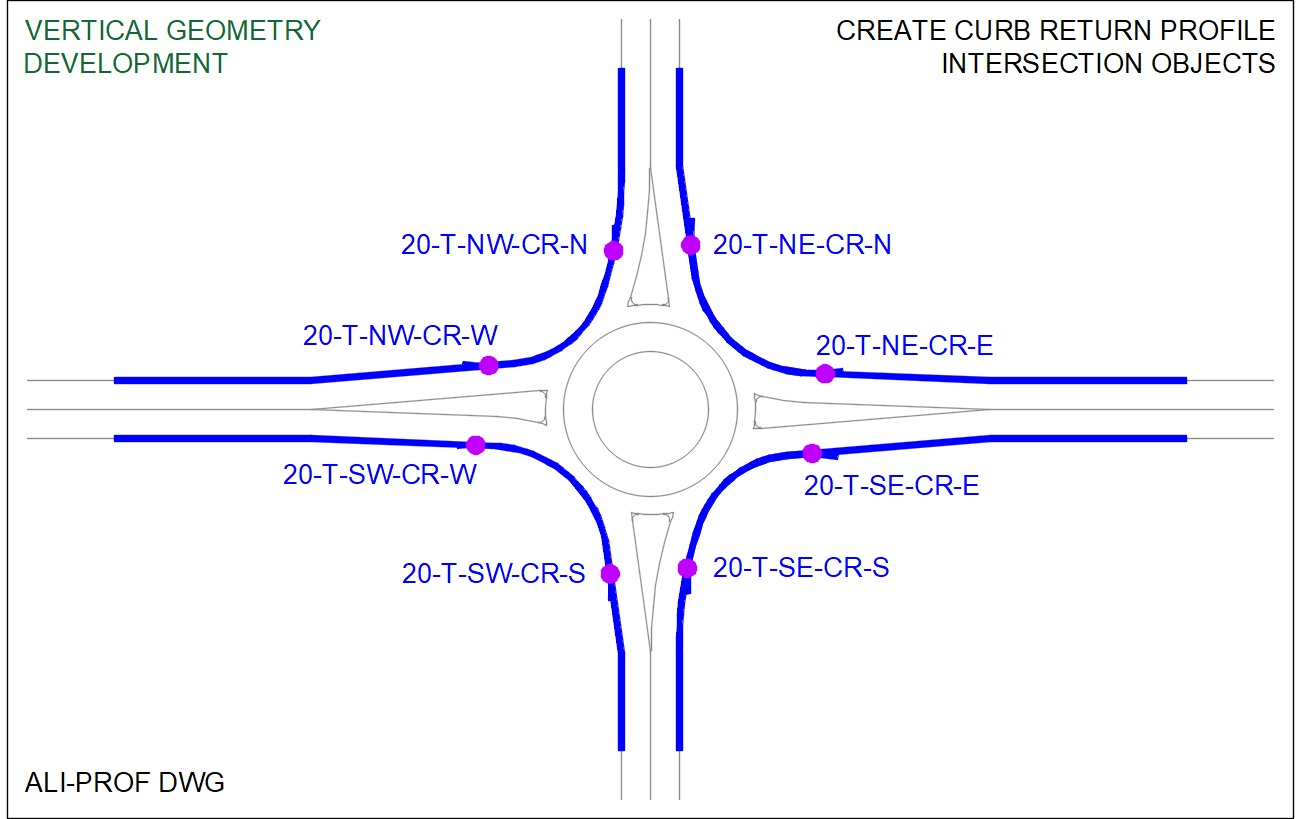
- Develop curb return profiles
With intersection object controlling the ends of the curb return profiles the curb return profiles can now be developed using the min and max surfaces that were create with the crowned setup corridor.
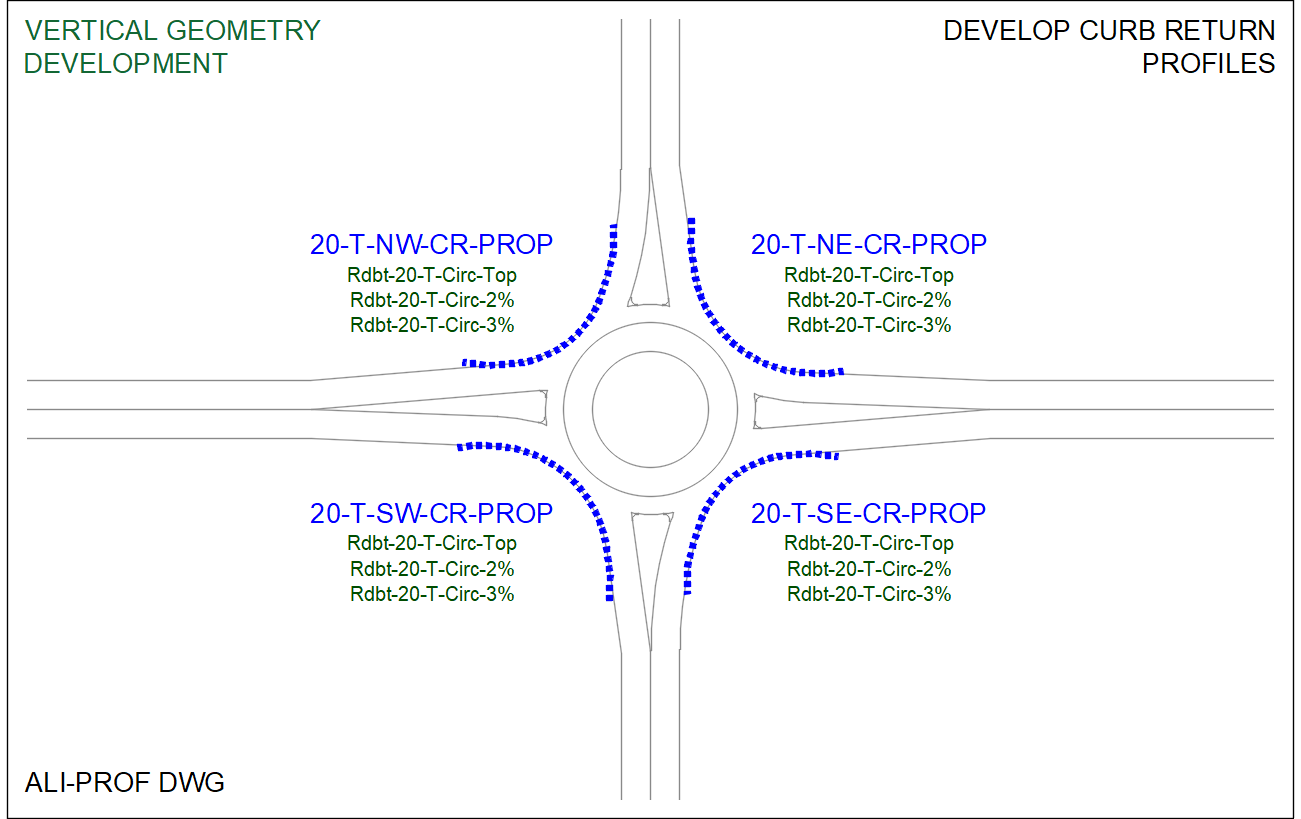
- Vertical hierarchy control model - Profiles and intersection objects
We may now see the concept in its entirety. All the profile and intersection objects that form the backbone of the vertical hierarchy control. The basic linear process of the vertical hierarchy control is to create a titled plane surface, create a surface profile, create a setup surface, tie two profiles together with and intersection, then repeat outward from the titled plane surface to the outer circulatory roadway to the approach roadway legs and match lines.
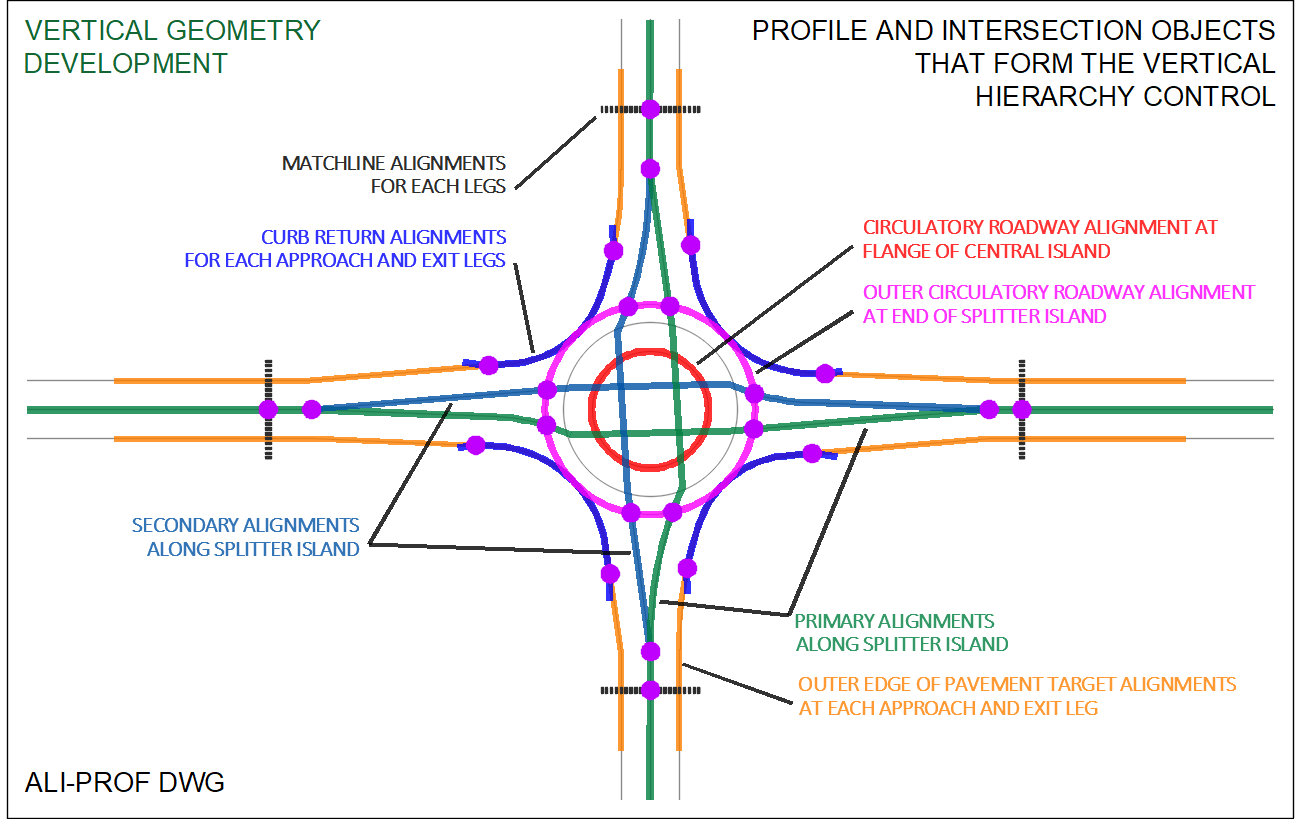
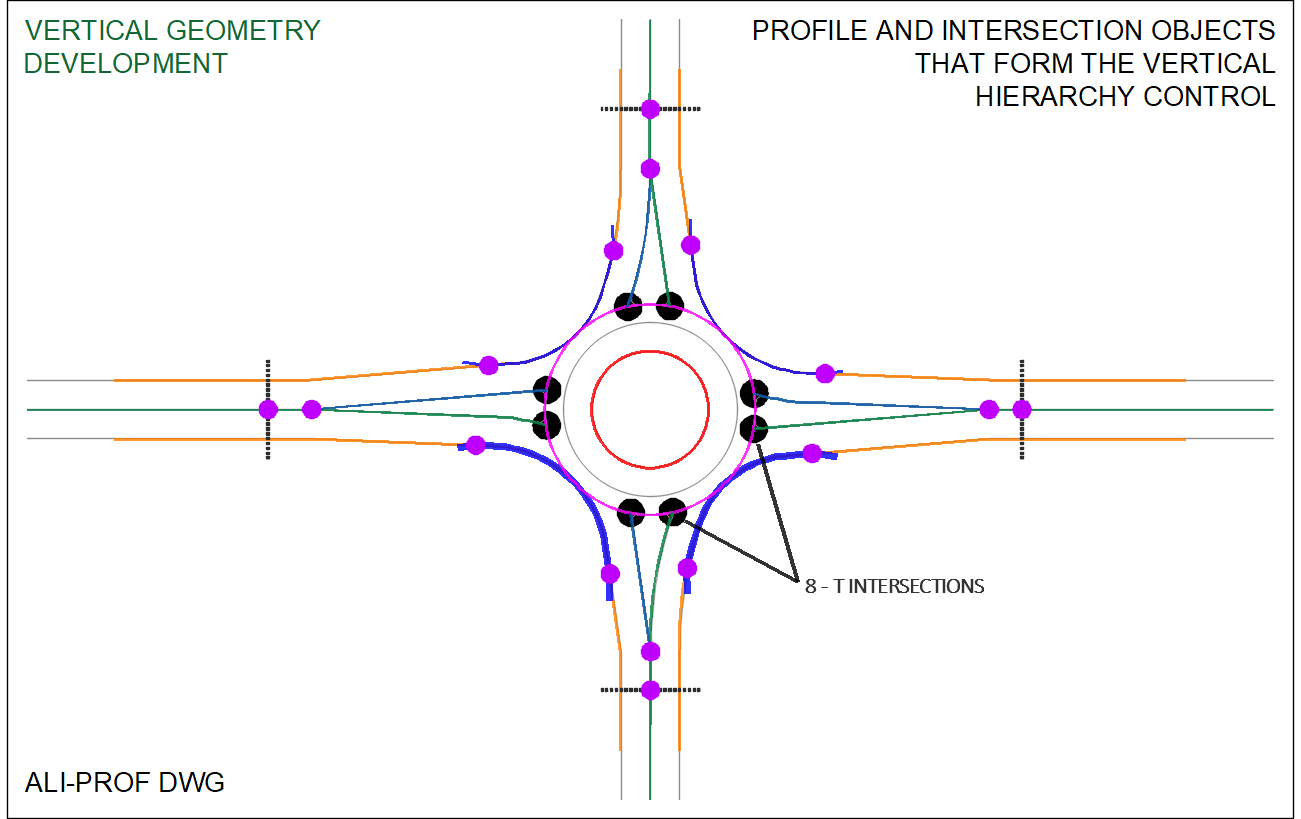
- Vertical hierarchy control model - Titled plane and setup corridor surfaces
This is the vertical hierarchy control system surfaces, from the titled plane to the setup corridor surfaces.
- Level one surface of the vertical hierarchy control is the tilted plane.
- Level two surface is the crowned setup corridor surface.
- Level three surfaces are the primary setup corridor surfaces.
- Level four surfaces are the secondary setup corridor surfaces.
Info: The crowned setup corridor also provides the cross slope envelop surfaces that define the curb return profile limits.
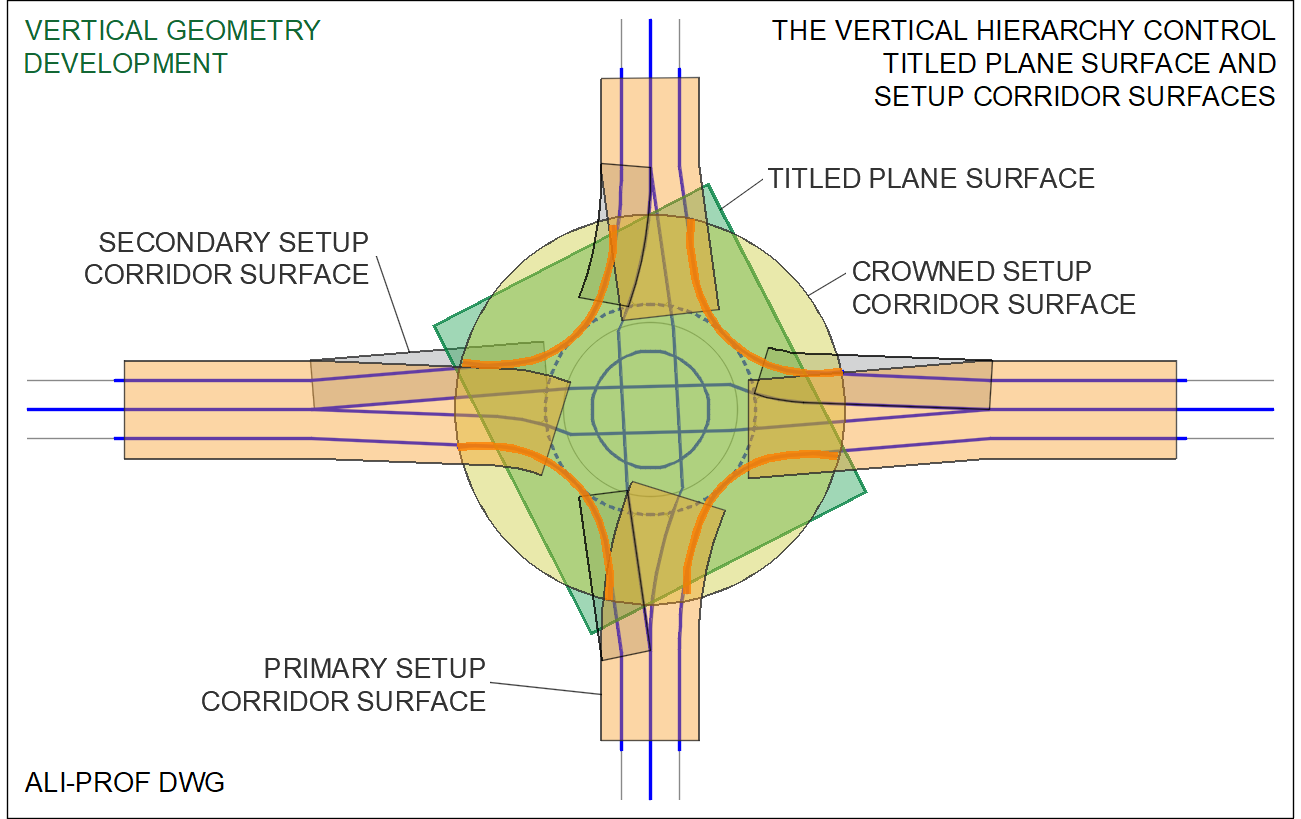
 Corridor layout
Corridor layout
Video: rndbt-vrtcl-dsgn-intro-05.mp4 2:11
Corridors, regions and baseline layout
Now that we have sketched out the elements and process for developing the vertical control backbone, we can fine tune the various profiles to meet cross slope and design criteria for drivability and drainage by modifying the titled plane and setup corridor cross slopes and design profiles as needed.
In the rest of the storyboard, we will outline the process to develop corridors to create the top and datum refinement surface dwg.
The most important concept at this point is to understand that there is no single modeling tool or workflow that will work for every roundabout or within a single roundabout. The focus should be on finding ways to develop the feature lines or breaklines that define the roundabout.
Before jumping in and developing any corridors, a layout of the corridors, regions, grading objects and feature lines should be carefully created. Corridors always run perpendicular to the baseline used, so regions should be developed to maximize perpendicular efficiency within the roundabouts diverging and curved geometry. The baselines and region locations should consider the vertical hierarchy system to minimize the need for multiple targets where possible.
Some areas of the roundabout may be defined by the corridor surrounding it and may not need to be developed as a region. These cases illustrate the need to maintain top and datum point coding that can be used to extract top and datum feature lines form the corridors. Understanding the use of boundaries and the hierarchy of pasting surfaces together to define the refinement surface is also used to determine our corridor layout.
This corridor layout drawing will be used as a referenced overlay into design drawings to be used as a guide.
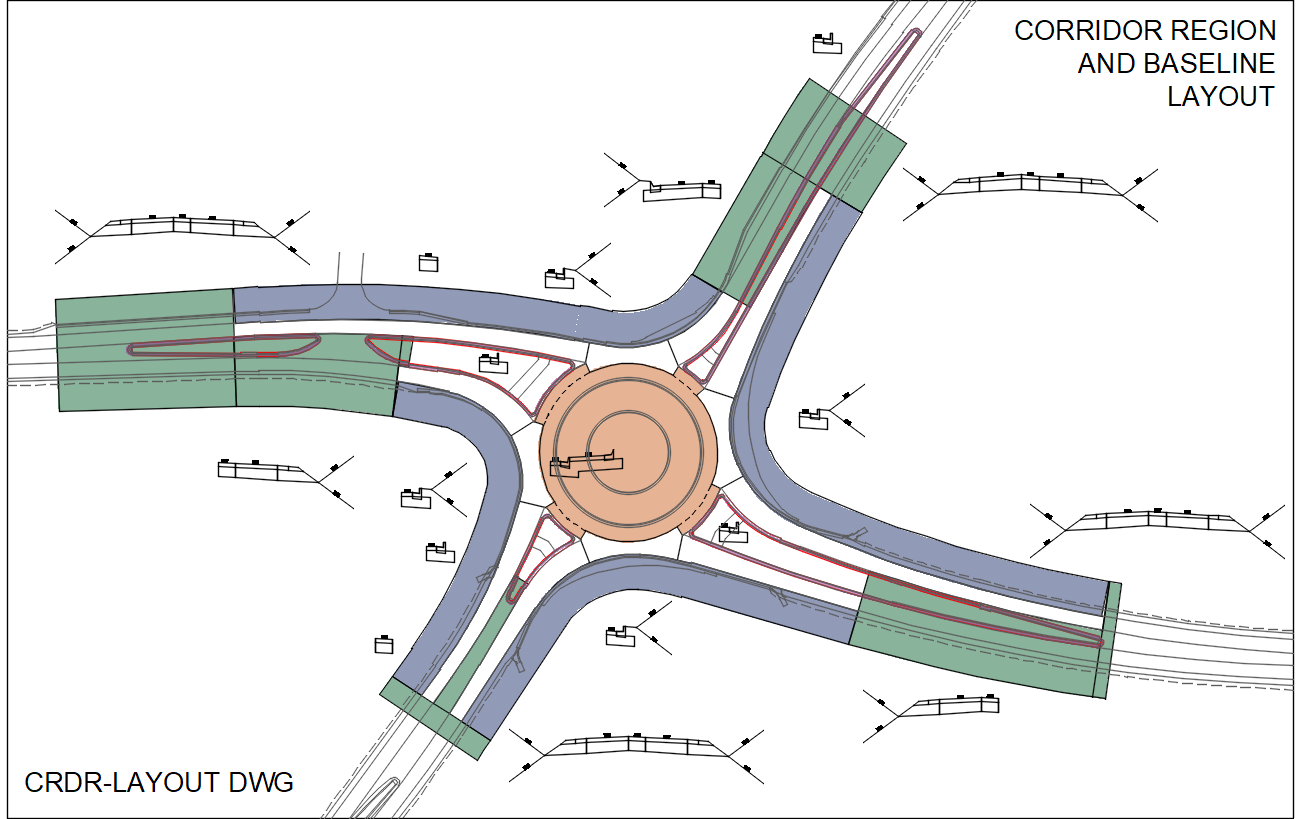
 Corridor surface development
Corridor surface development
Video: rndbt-vrtcl-dsgn-intro-06.mp4 2:06
- Create circulatory roadway corridor
First up is creating the circulatory roadway corridor. This corridor is much different than the setup corridor as its subassemblies will be fully developed to create the circulatory roadway lane, curb, and truck apron. The lane will target the setup corridor surface and conditionally target the ends of the splitter islands.
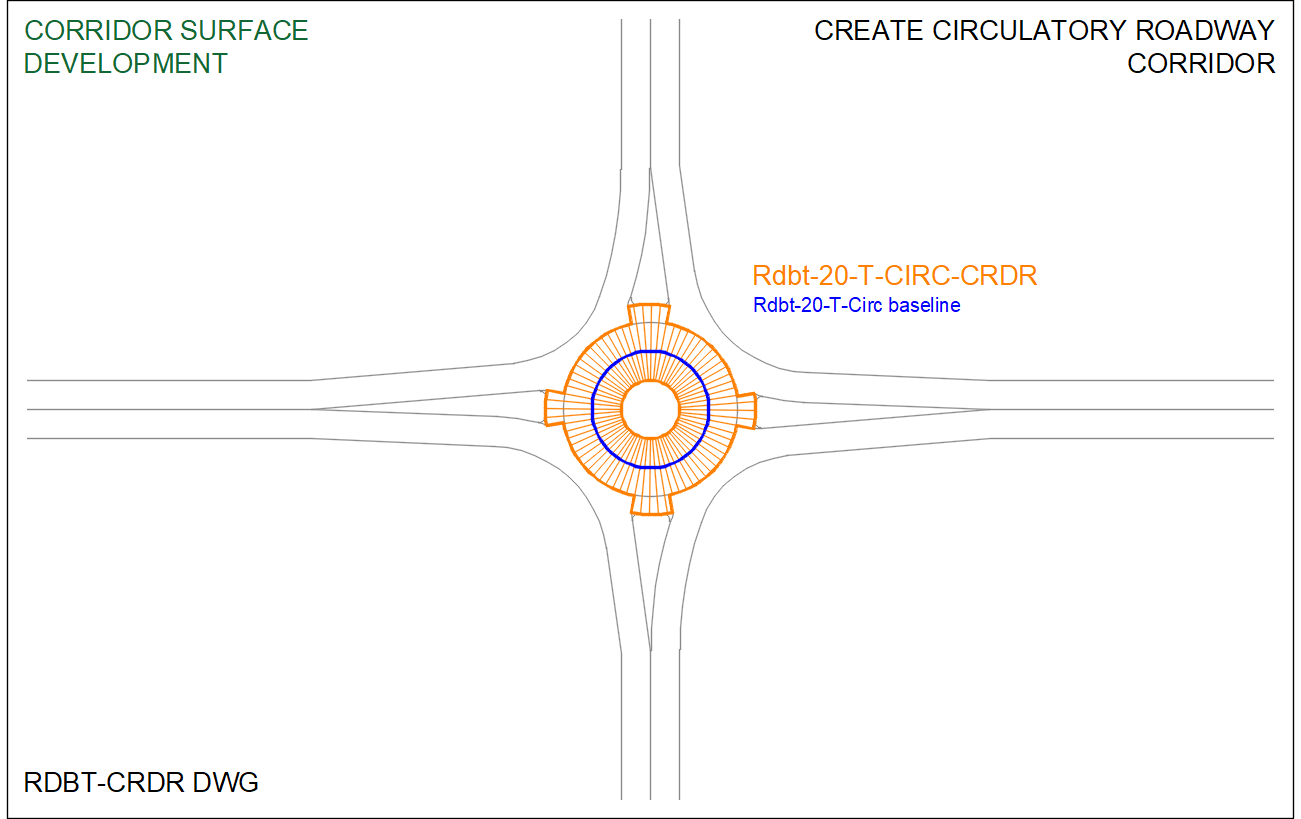
- Develop roundabout corridor region along east bound baseline
For the approach and exit sections of the roundabout develop a single corridor with multiple baseline regions. This is the east bound baseline (primary alignment) from the match line towards the start of the curb return.
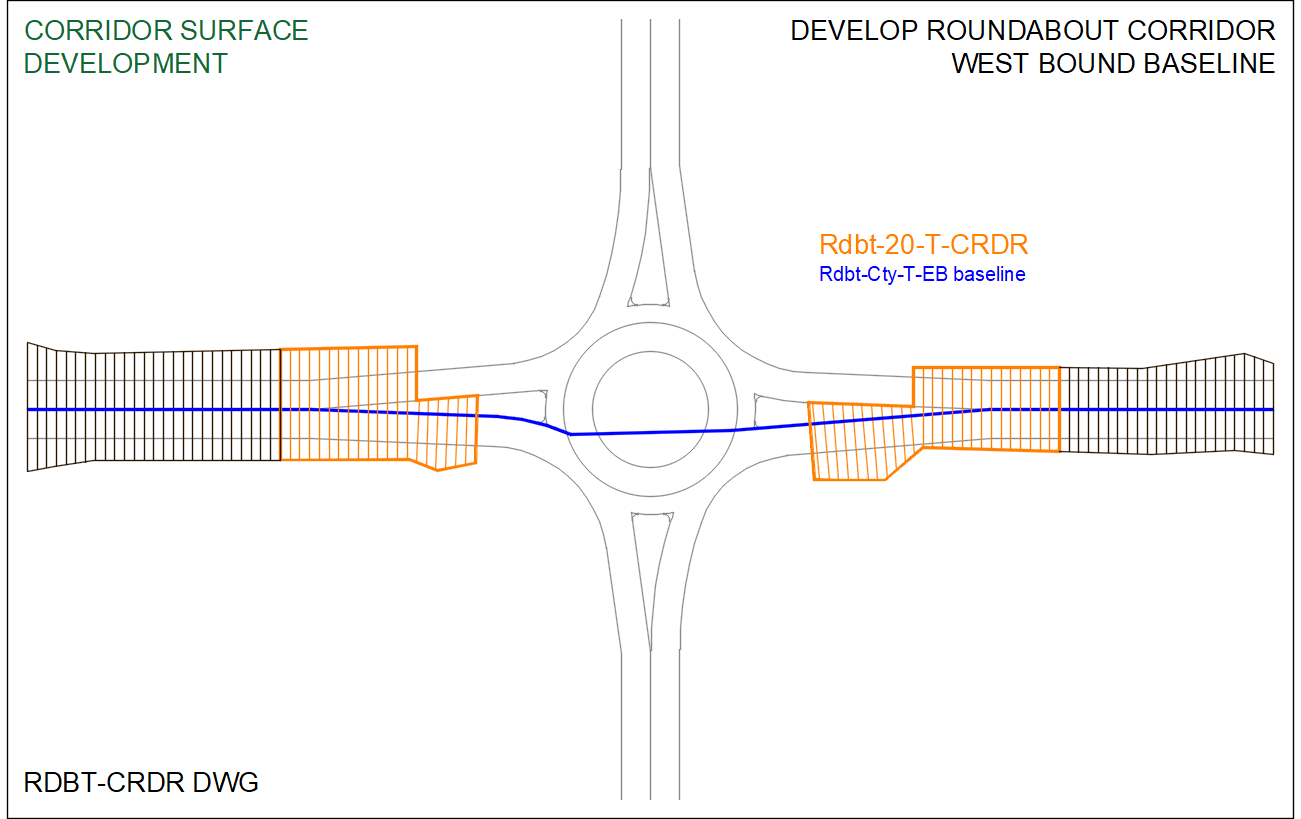
- Develop roundabout corridor region along west bound baseline
Develop the west bound corridor baseline region from the match line towards the start of the curb return. These regions should extend along the secondary alignment as far as possible until the corridor frequencies begin to skew away from being perpendicular toany lane areas.
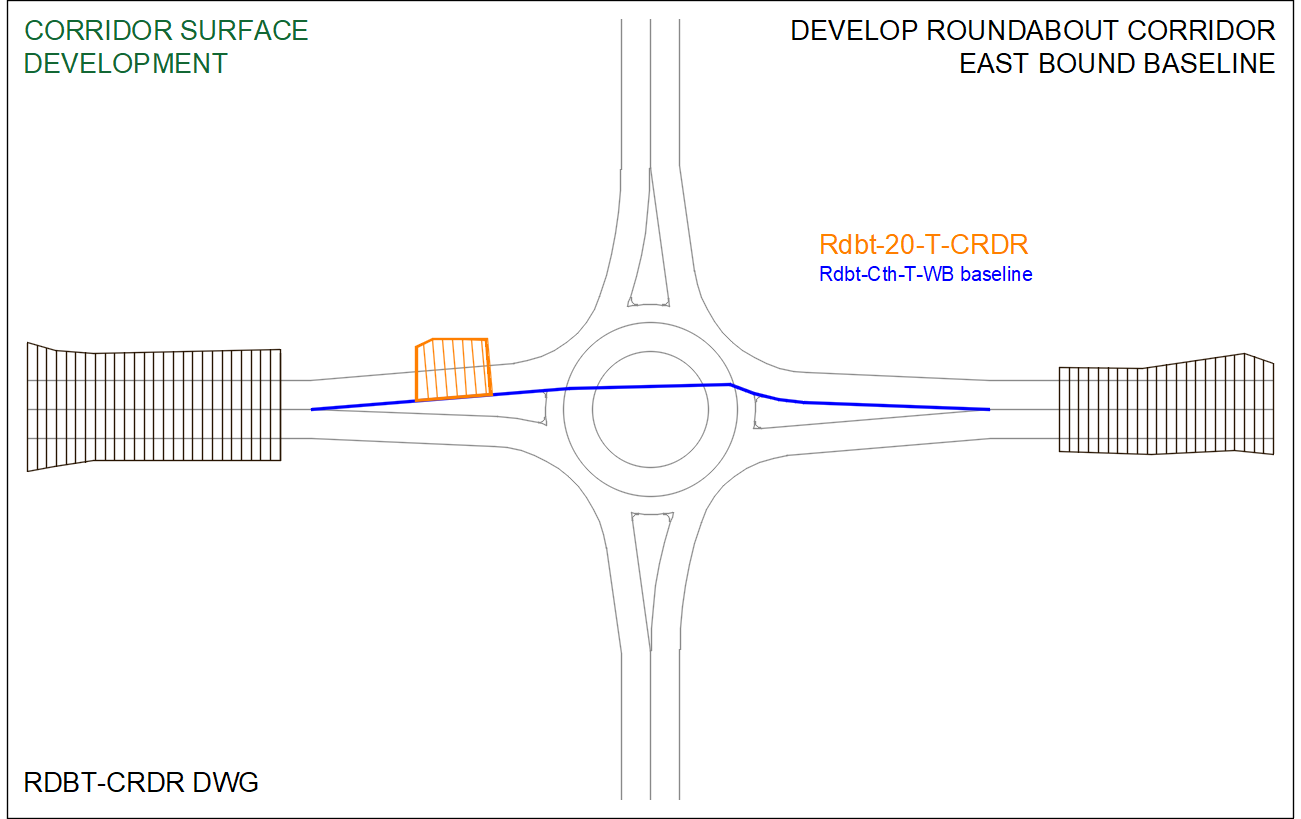
- Develop roundabout corridor region along north bound baseline
Develop the north bound corridor baseline region from the match line towards the start of the curb return. These region locations should have been pre-developed during the corridor layout sketch in consideration with maintaining perpendicular lane areas and using the edge of corridor regions to establish “warped” cross section transition areas without developing regions in those areas… These areas are in the tapered exit areas and the entry deflection areas where the lanes widen and the geometry deviates dramatically from being perpendicular to the baselines.
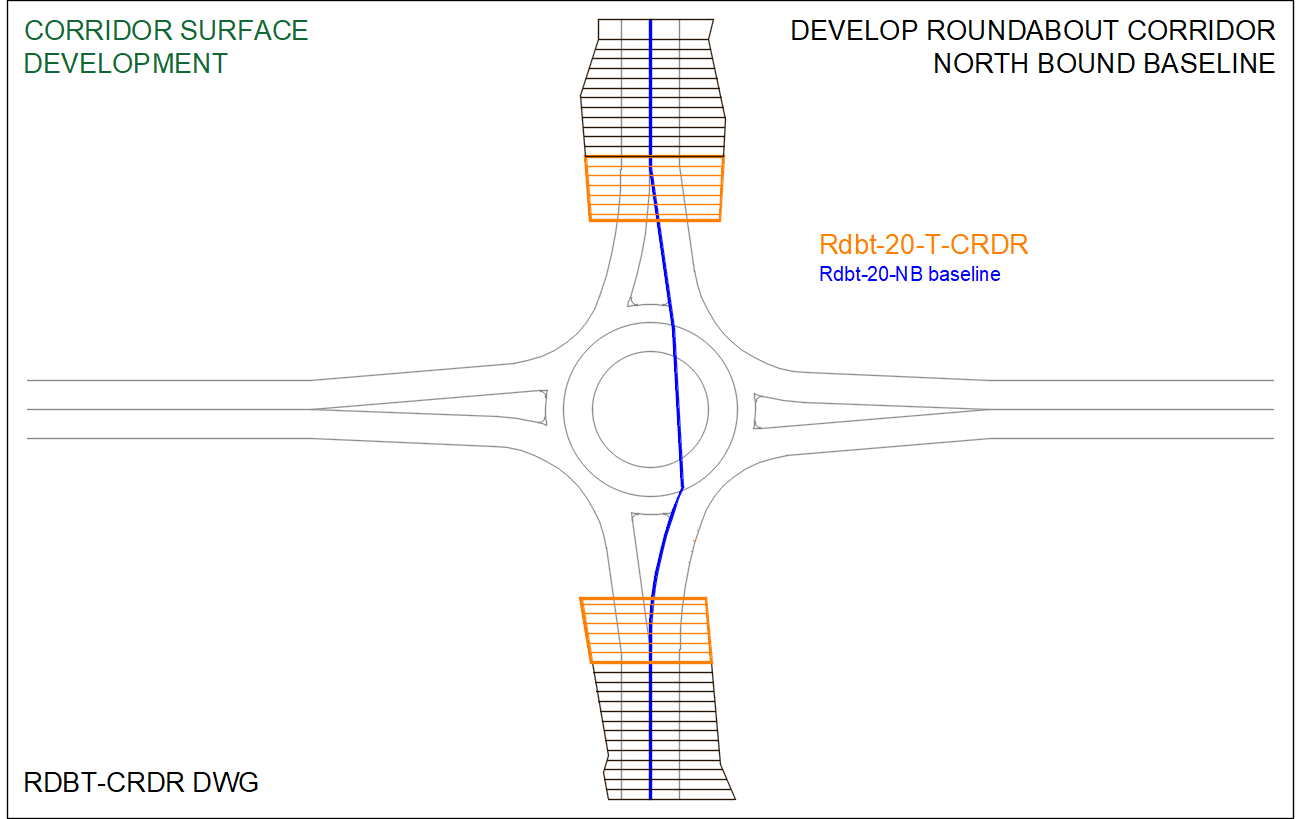
- Develop roundabout corridor region along south bound baseline
Develop the south bound corridor baseline region from the match line towards the start of the curb return.
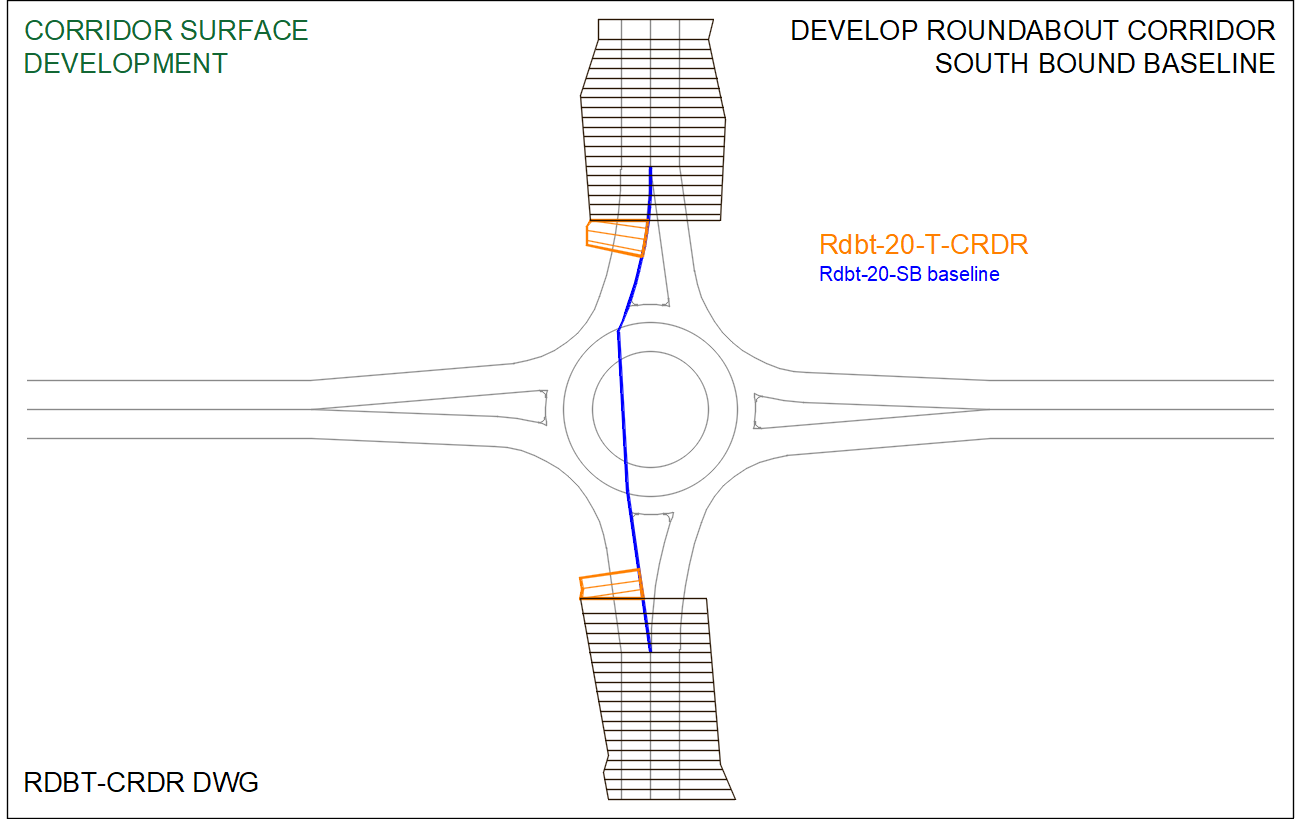
- Develop curb return corridors
Develop the four curb return corridor regions. These regions also include the curb end condition areas. The baseline for these are the curb return alignments.
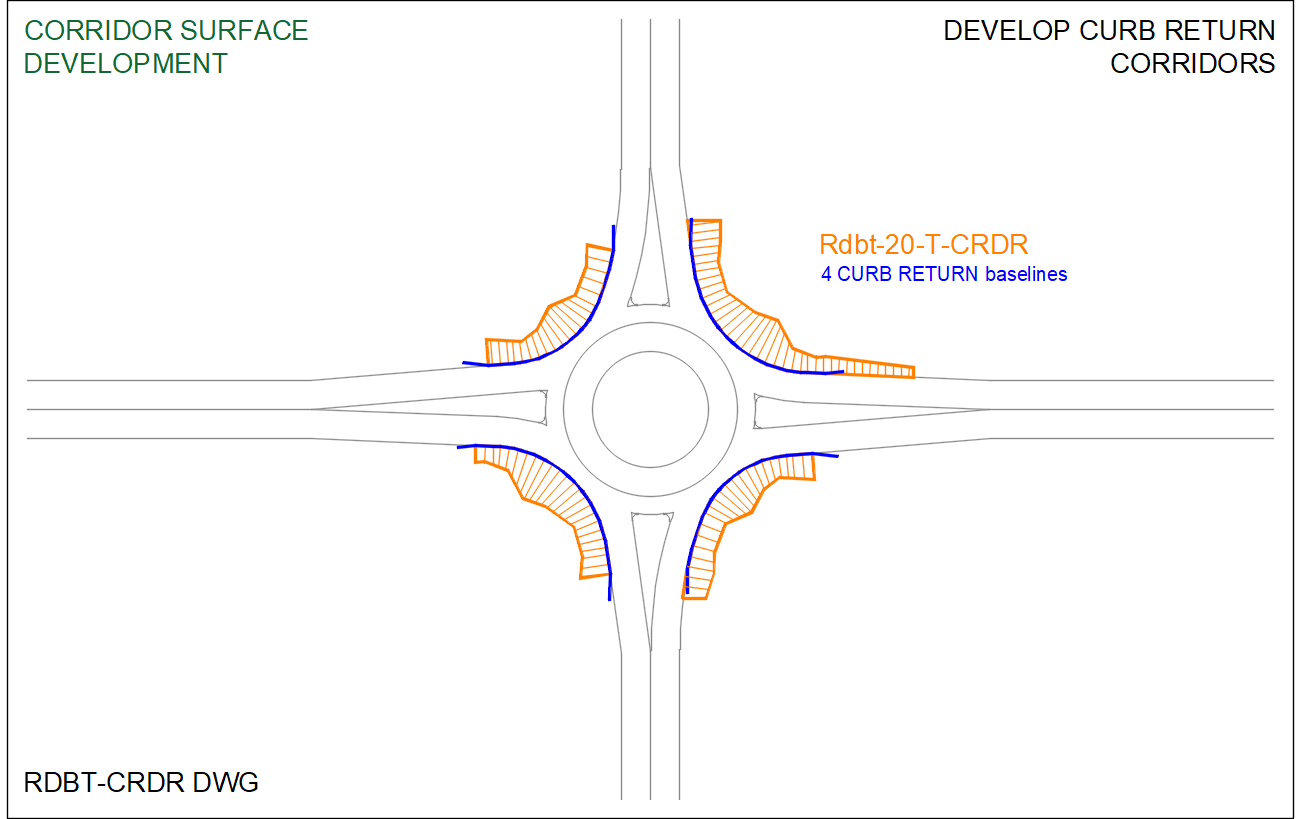
- Create splitter island setup corridor top surface
Create a splitter island setup corridor based on the primary and secondary design profiles for each island. Create a single top surface from the corridor.
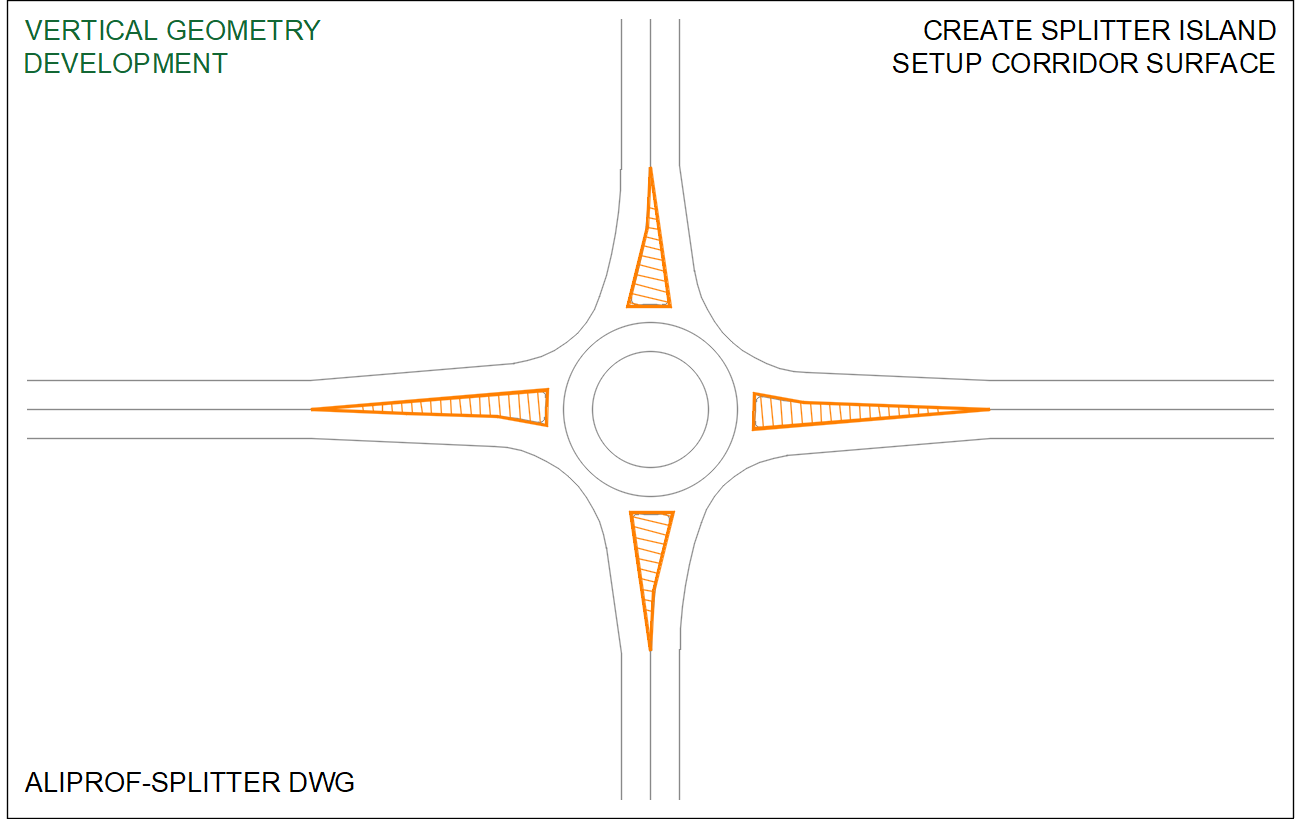
- Create splitter island alignments
Create the splitter island alignments from the geometry objects extracted from the roundabout edge line dwg.
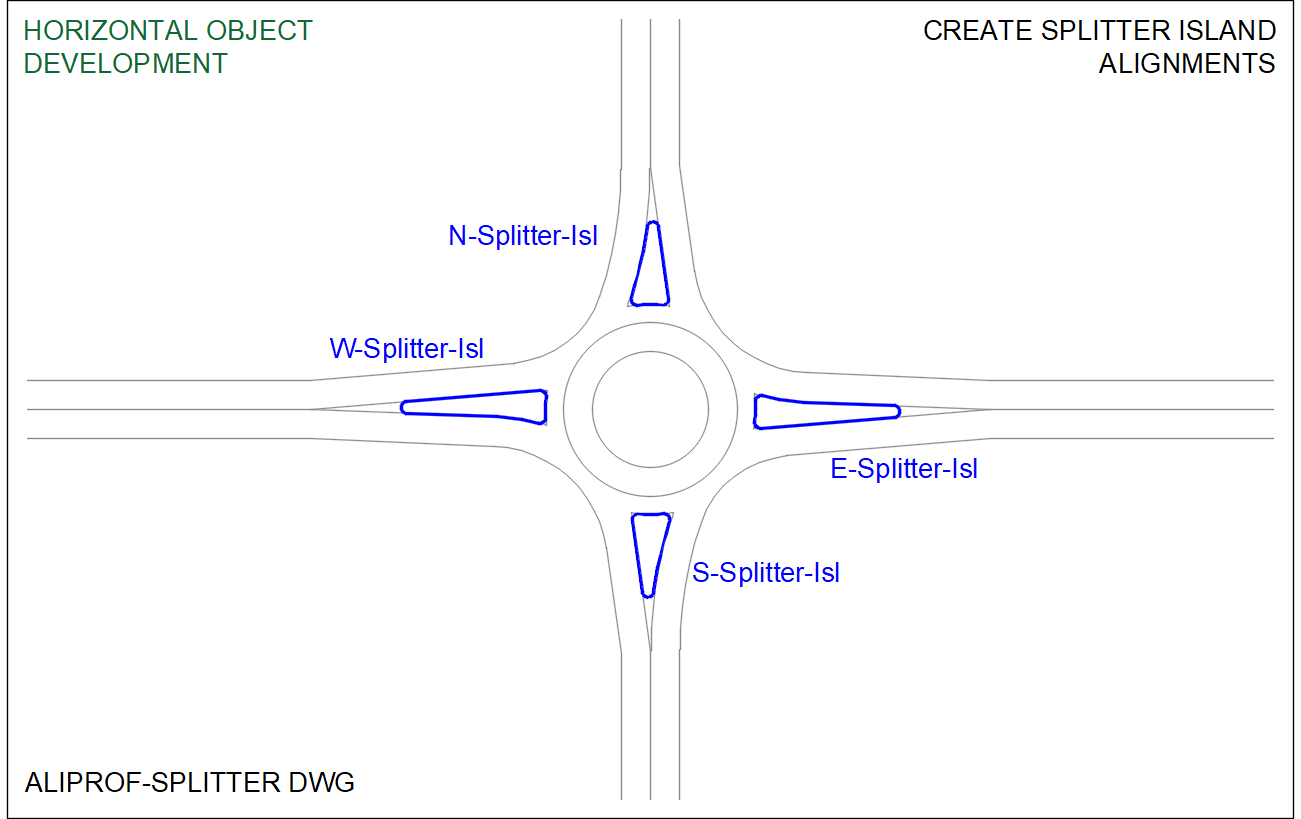
- Create splitter island profiles
Create splitter island profiles from the splitter island setup surface. Maintain these profiles as surface profiles unless design profiles are desired for final deliverable needs.
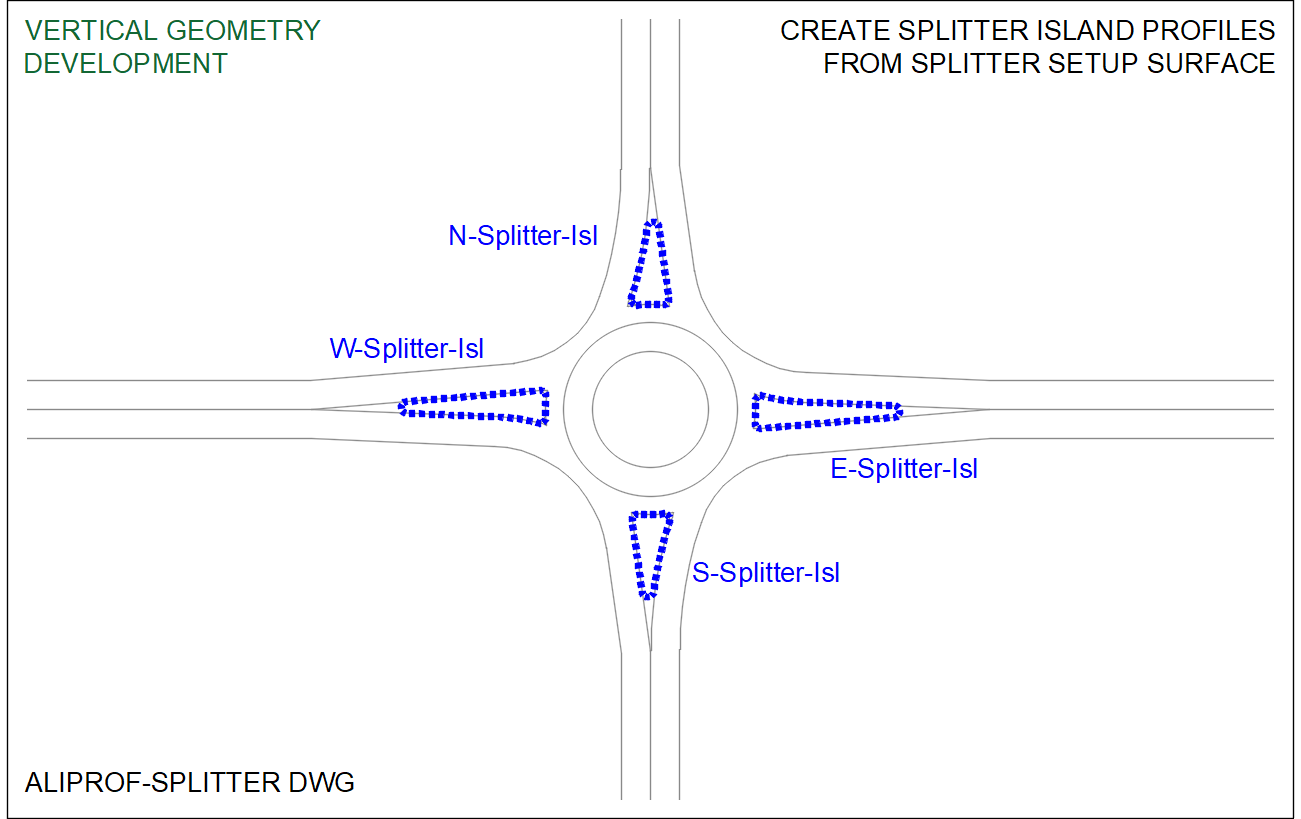
- Create splitter island corridor
Create the splitter island corridor. Create a top and datum splitter island surface and border for each island corridor region.
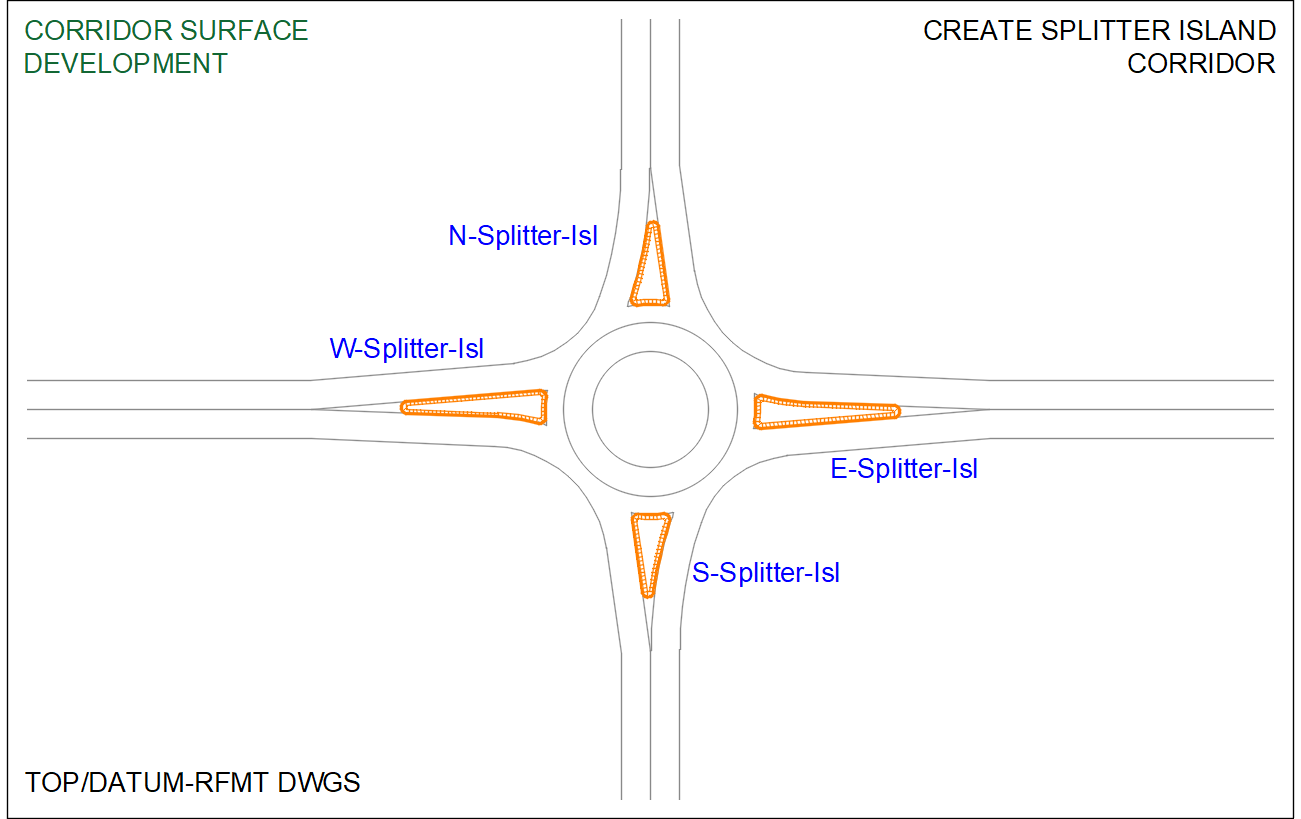
- Create approach corridor surface boundaries
Create a top and datum boundary for each surface in each approach corridor drawing.
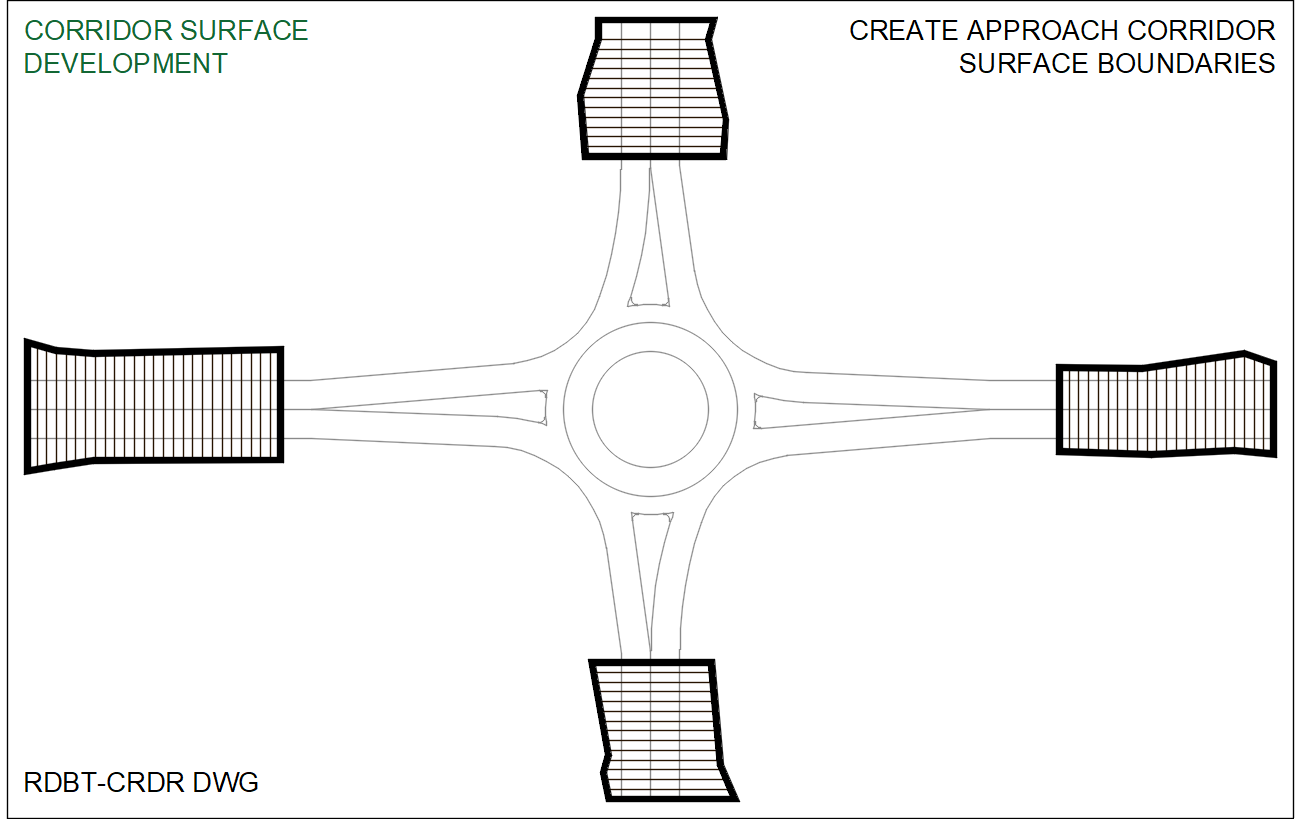
 Refinement surface development
Refinement surface development
Video: rndbt-vrtcl-dsgn-intro-07.mp4 3:22
- Data reference corridors and surfaces in refinement surface drawings
With the corridors created the refinement surface drawing may now be developed. To create the refinement surface dwgs each approach leg top and datum surfaces will be data referenced into the appropriate drawing.
This is where the process of creating the refinement surface may differ from other roadway workflows. A data shortcut of the roundabout corridors will be added to the refinement surface. The roundabout corridor top and datum surfaces will be created in the refinement surface drawings.
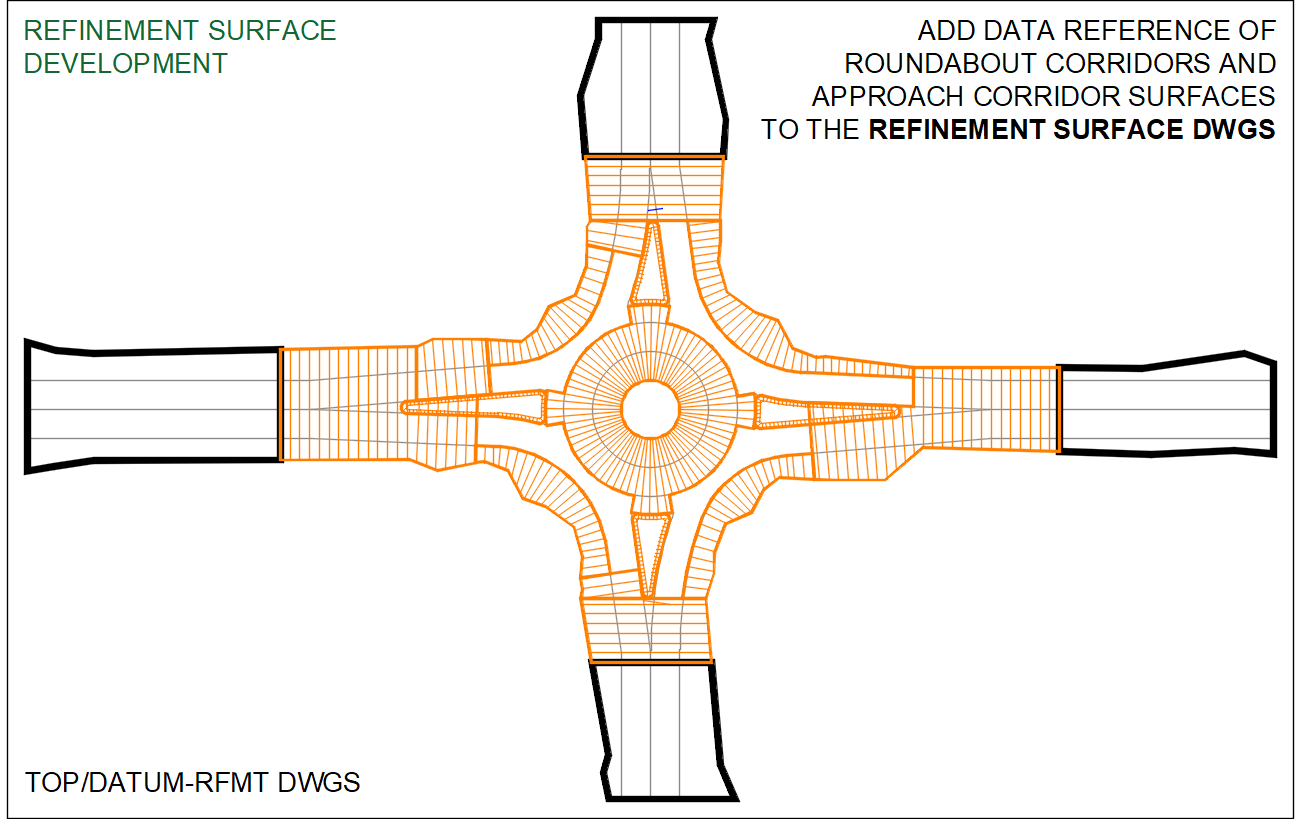
- Create top and datum surfaces from the roundabout corridors
This diagram also shows the different design corridors in a color code to illustrate the relationship between the separate corridors and show the baseline regions within the outer roundabout corridor. It also helps define the areas where a corridor object is not being created. These areas are within the lane section that connect to the curb returns on each leg.
The top and datum surfaces in these areas are defined by the edge of the corridor objects that encompass them and contain multiple transitioning cross slopes.
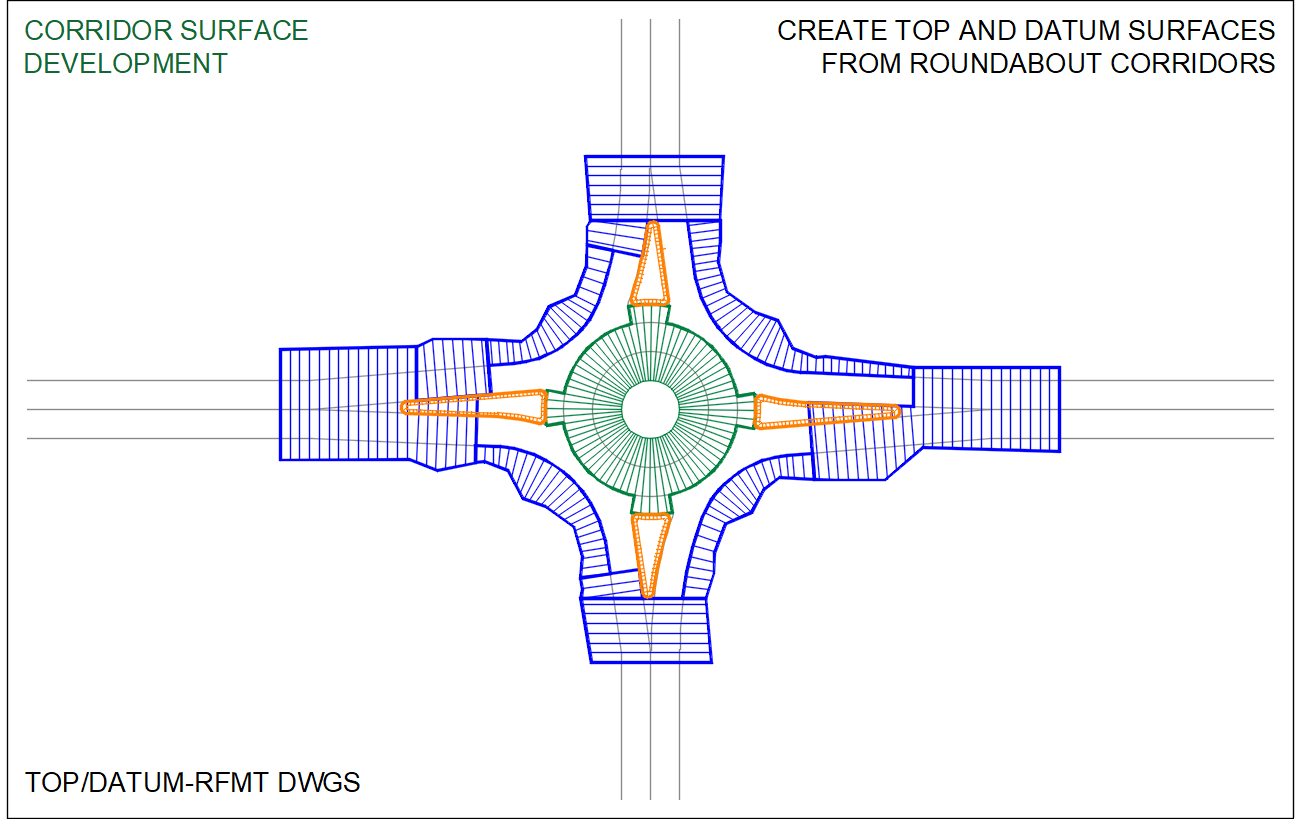
- Create dynamic featurelines
- Create dynamic featurelines from circulatory roadway
Create dynamic feature lines of the top and datum from the circulatory corridor. These feature lines will be used to cleanly define the top and datum refinement surfaces without needing to create infill corridor regions that will cause ripples in the surfaces.
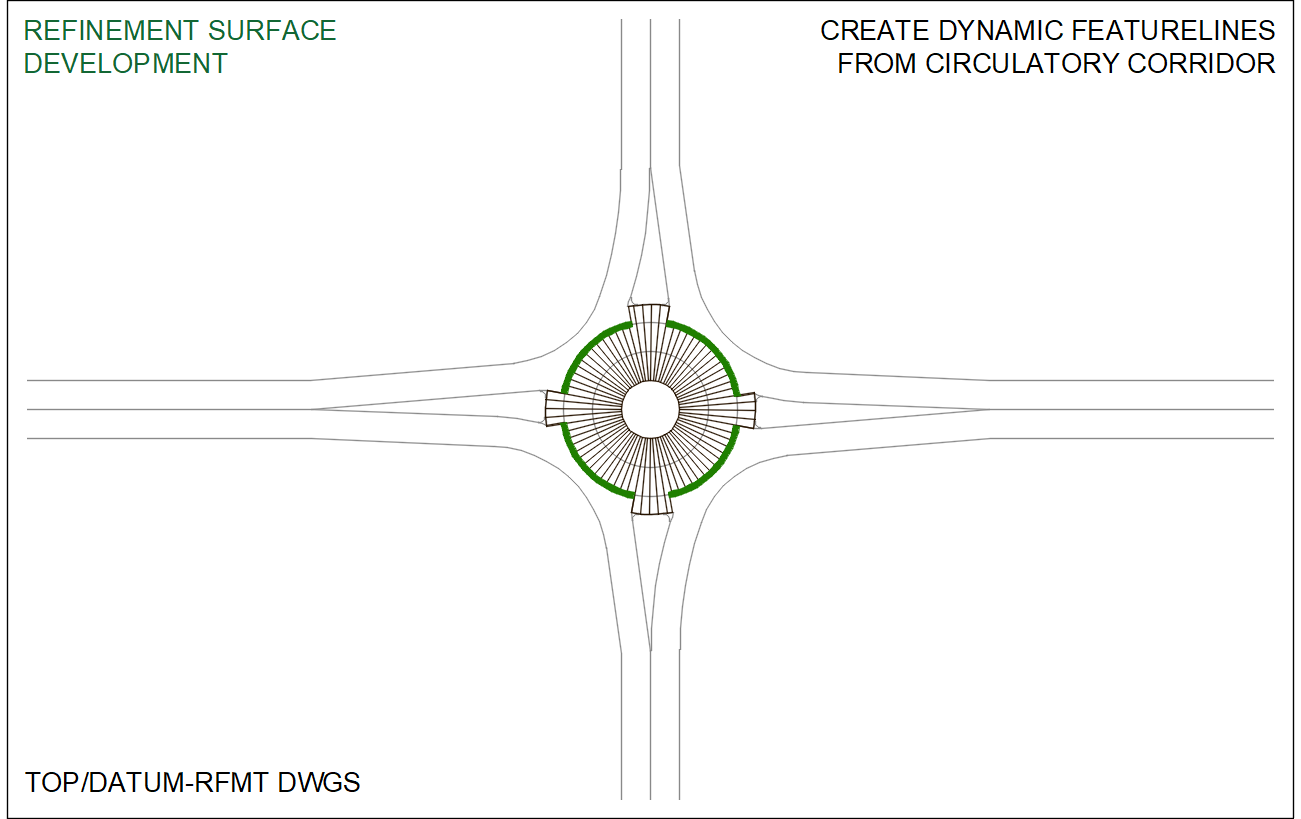
- Create dynamic featurelines from curb return corridors
Create dynamic feature lines of the top and datum from each of the curb return corridors.
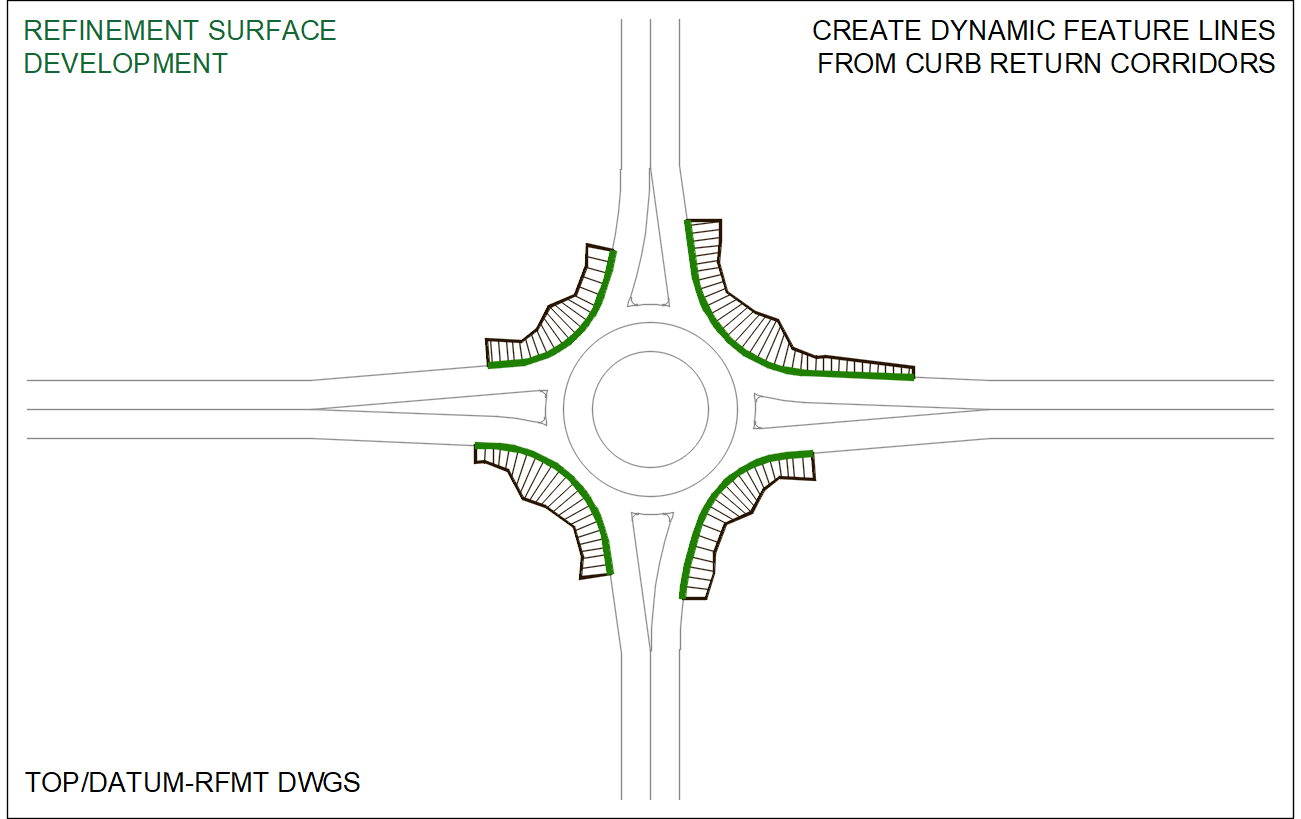
- Create dynamic featurelines from splitter island corridors
Create dynamic feature lines of the top and datum from each of the splitter island corridors.
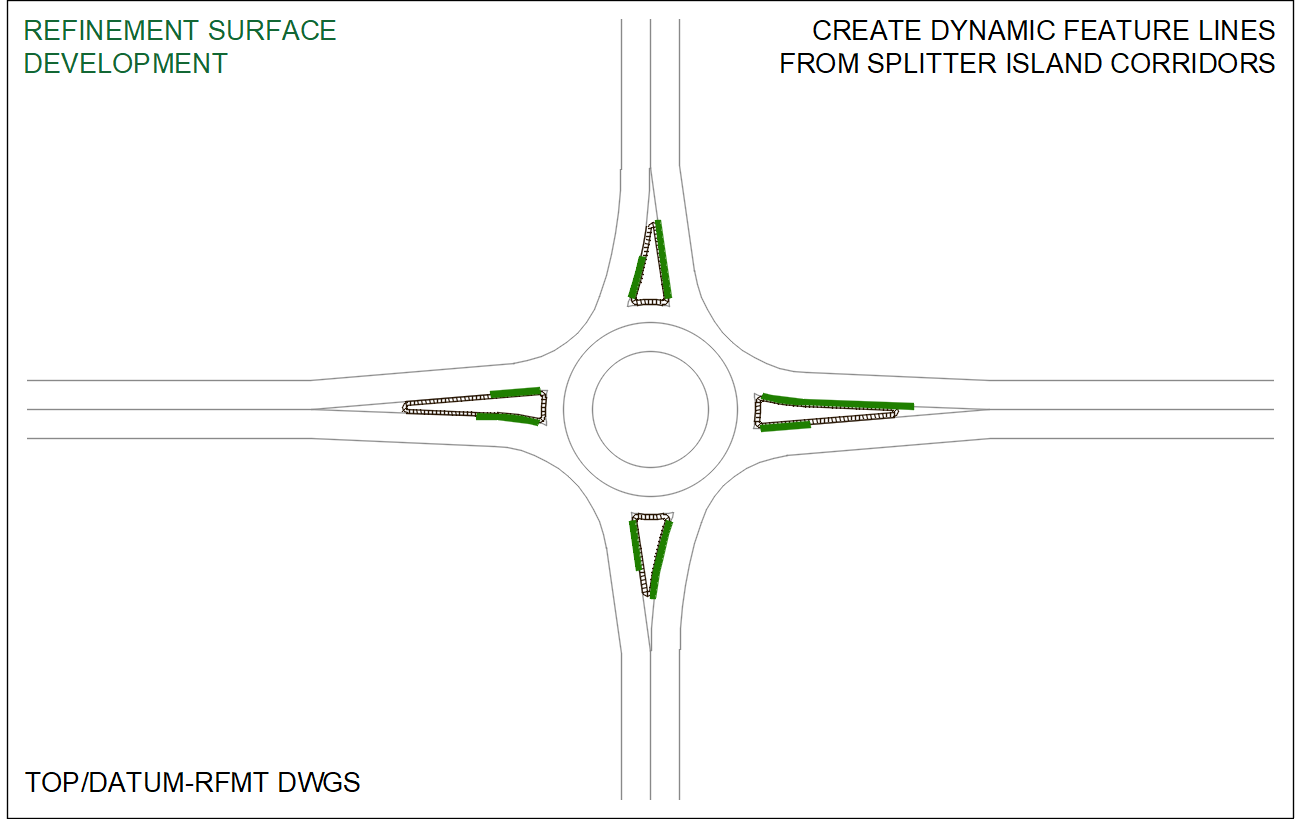
- Create dynamic featurelines from circulatory roadway
- Create circulatory roadway surface boundaries
Create a boundary for the top circulatory roadway corridor surface and datum circulatory roadway corridor surface.
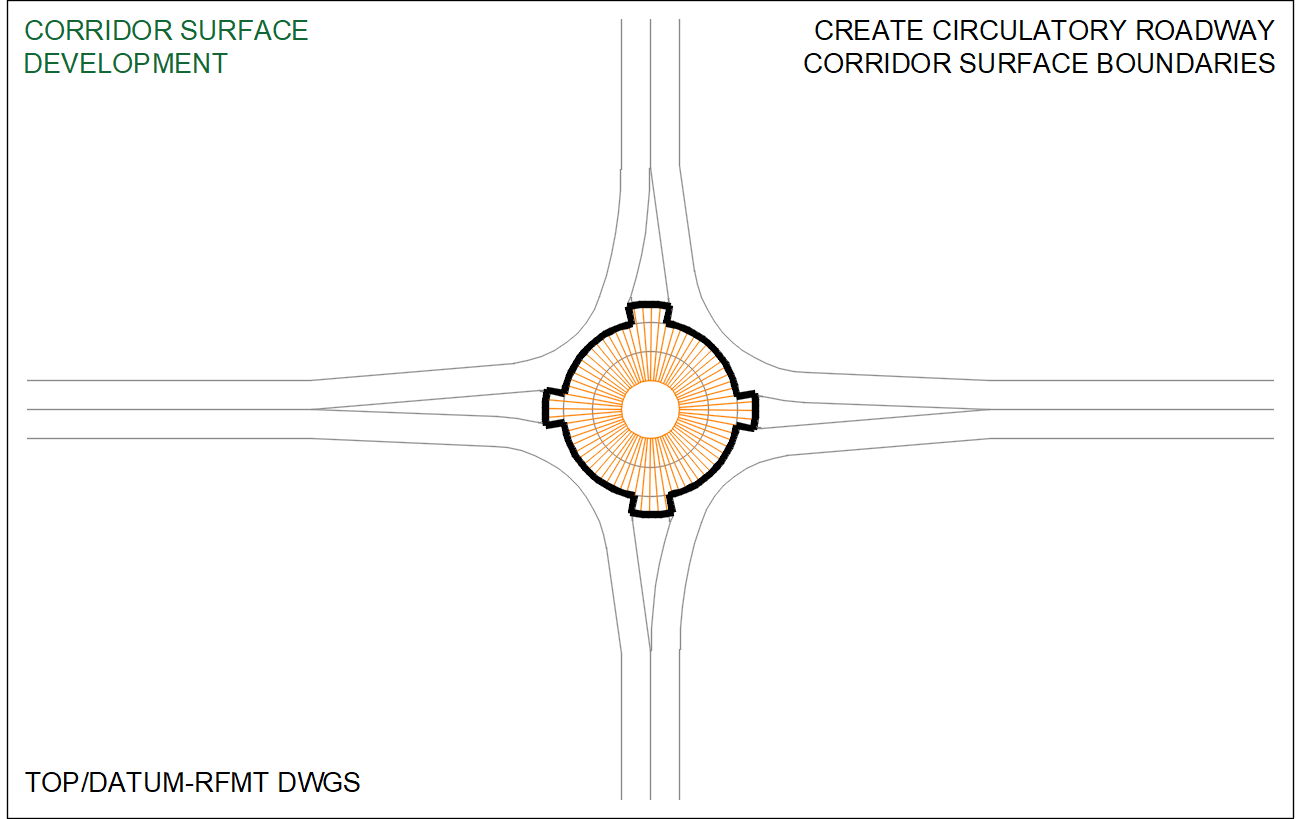
- Create roundabout corridor surface boundaries
Create an outer boundary for the top outer roundabout corridor surface and the datum outer roundabout corridor surface.
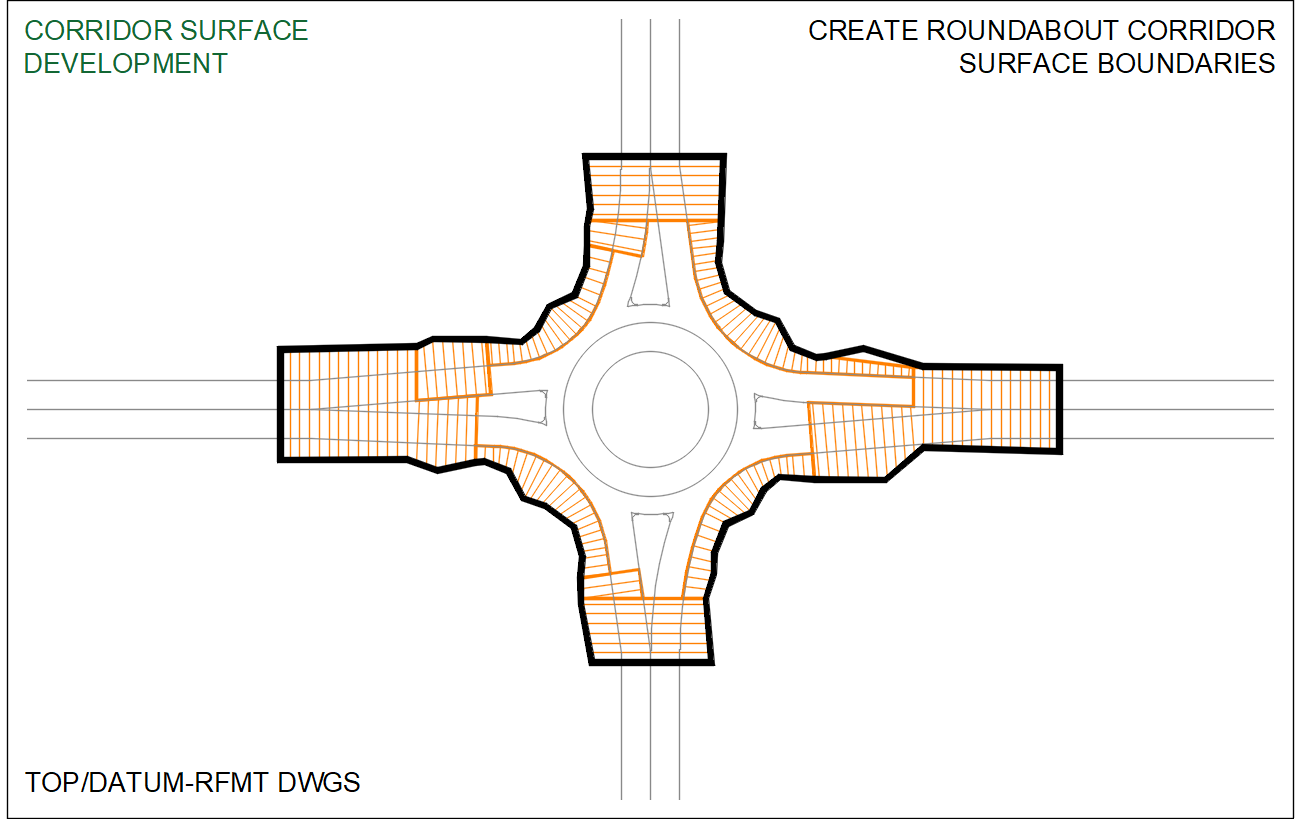
- Build refinement surfaces
- Paste approach corridor surfaces
Paste the approach leg corridor top surfaces into the refinement top surface and approach leg corridor datum surfaces into the refinement datum surface.
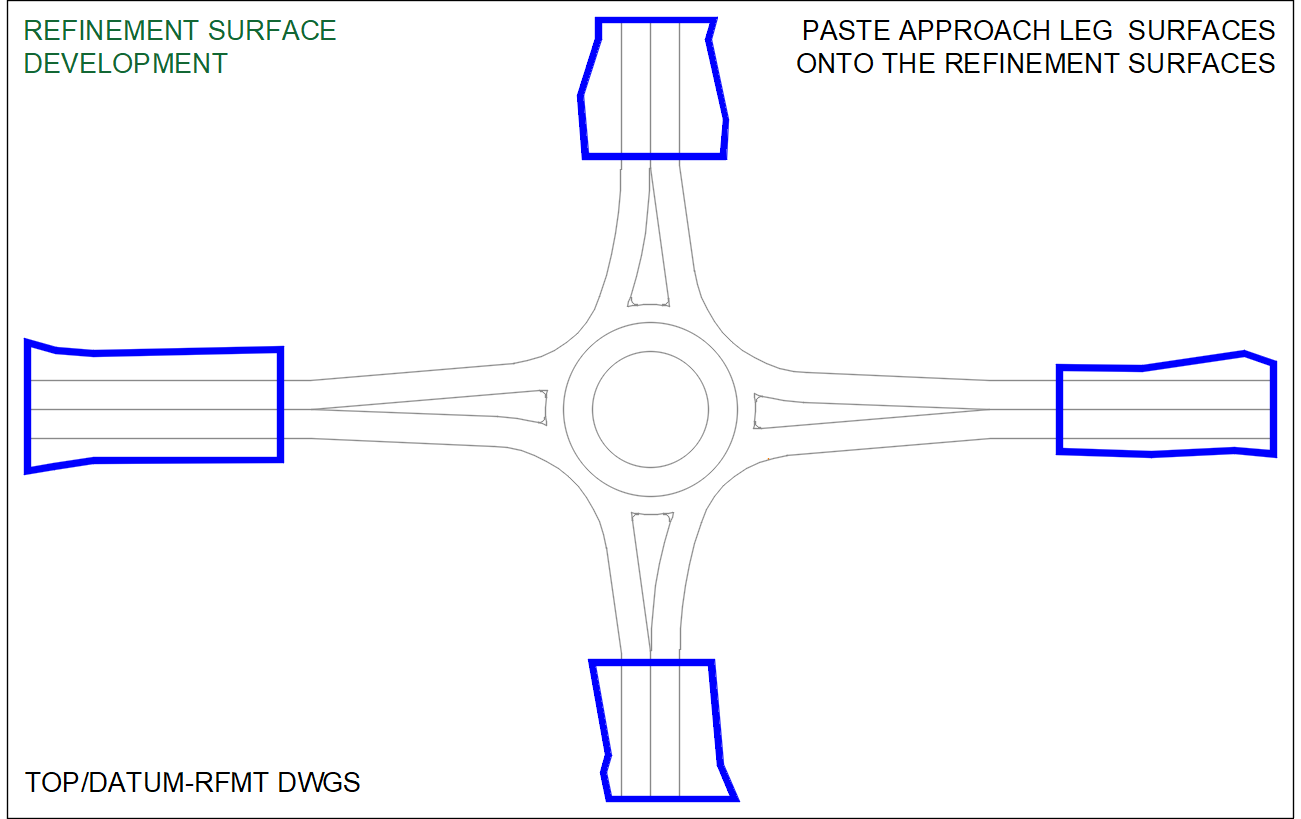
- Paste outer roundabout corridor surfaces
Paste the outer roundabout corridor top surface into the refinement top surface and outer roundabout corridor datum surface into the refinement datum surface.
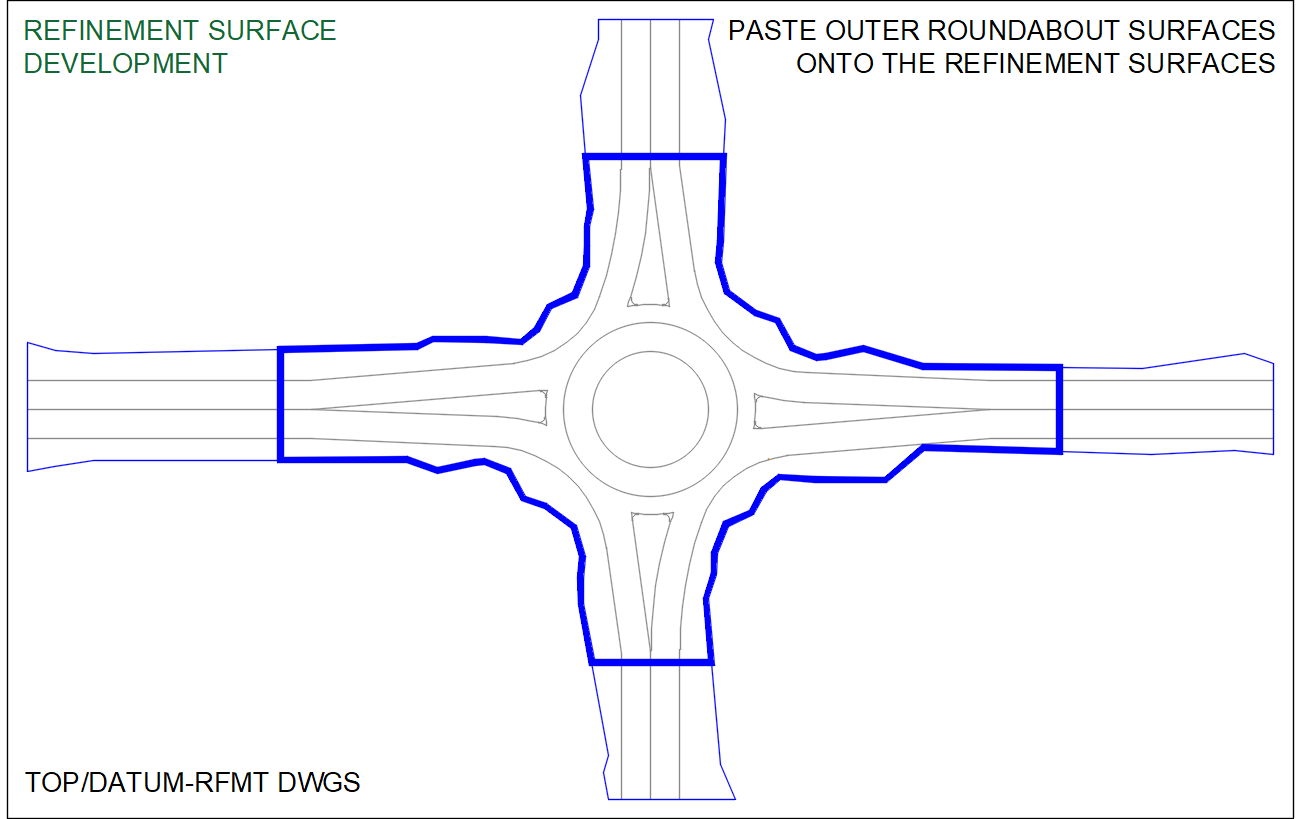
- Paste circulatory corridor surfaces
Paste the circulatory roadway corridor top surface into the refinement top surface and circulatory roadway corridor datum surface into the refinement datum surface.
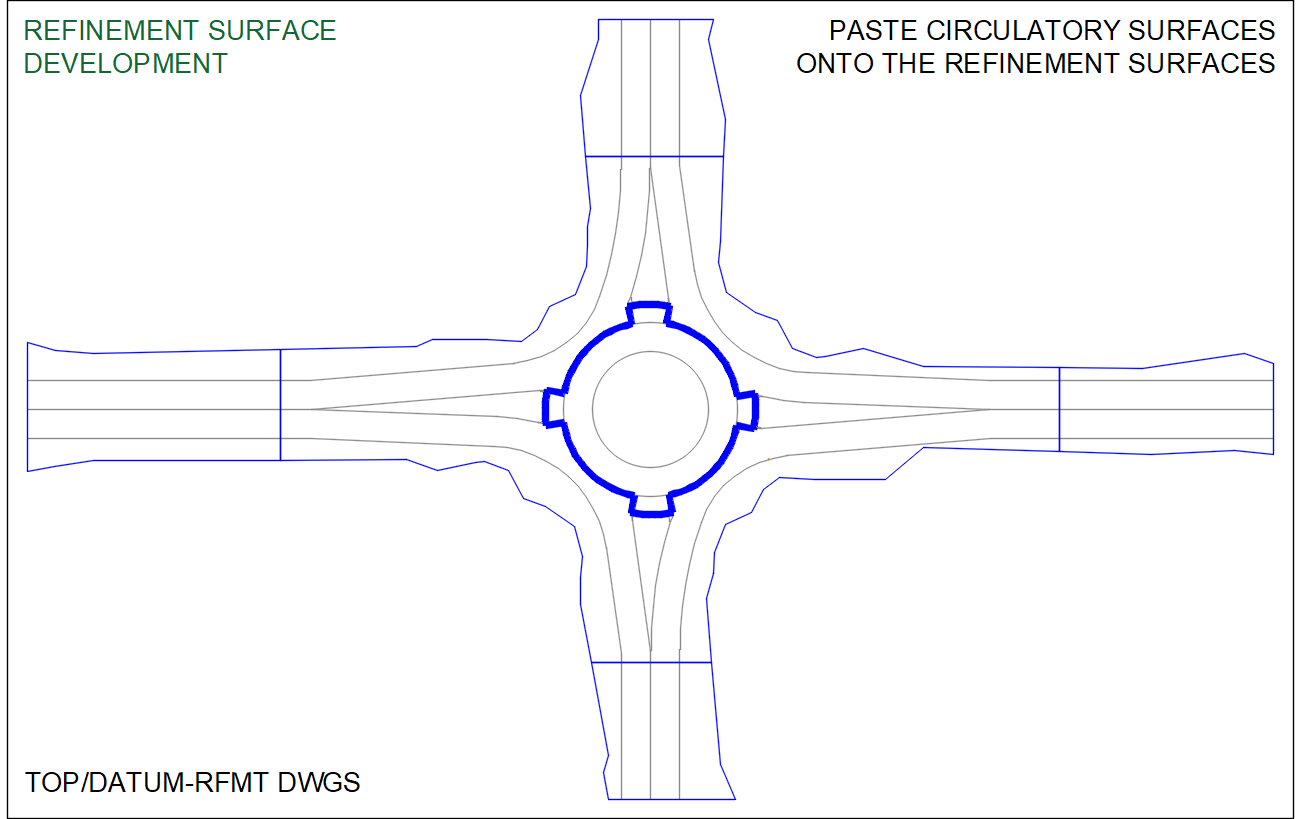
- Paste splitter island corridor surfaces
Paste the splitter island corridor top surface into the refinement top surface and splitter island corridor datum surface into the refinement datum surface.
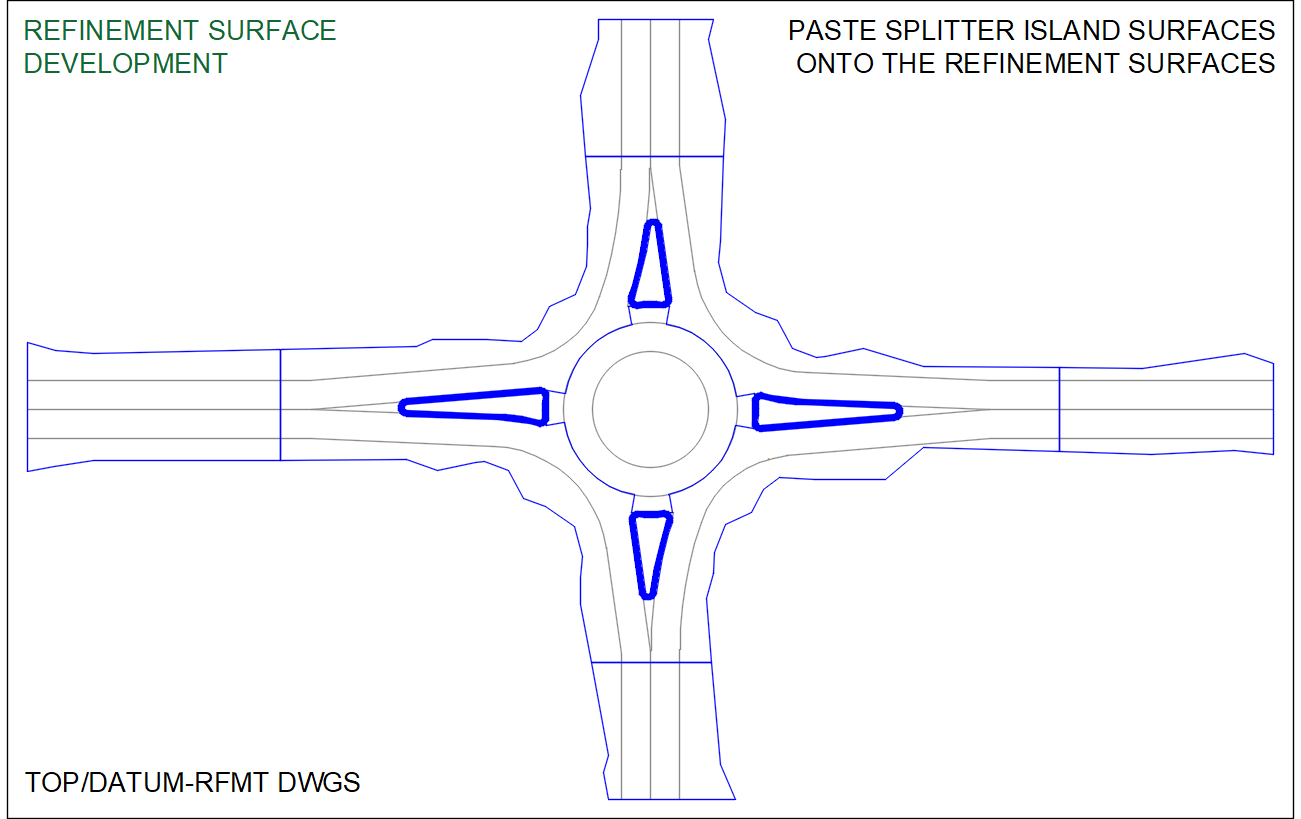
- Paste approach corridor surfaces
- Add dynamic feature lines to the refinement surfaces
Add the top surface dynamic feature lines to the top refinement surface definitions and add the datum surface dynamic feature lines to the datum refinement surface definitions.
